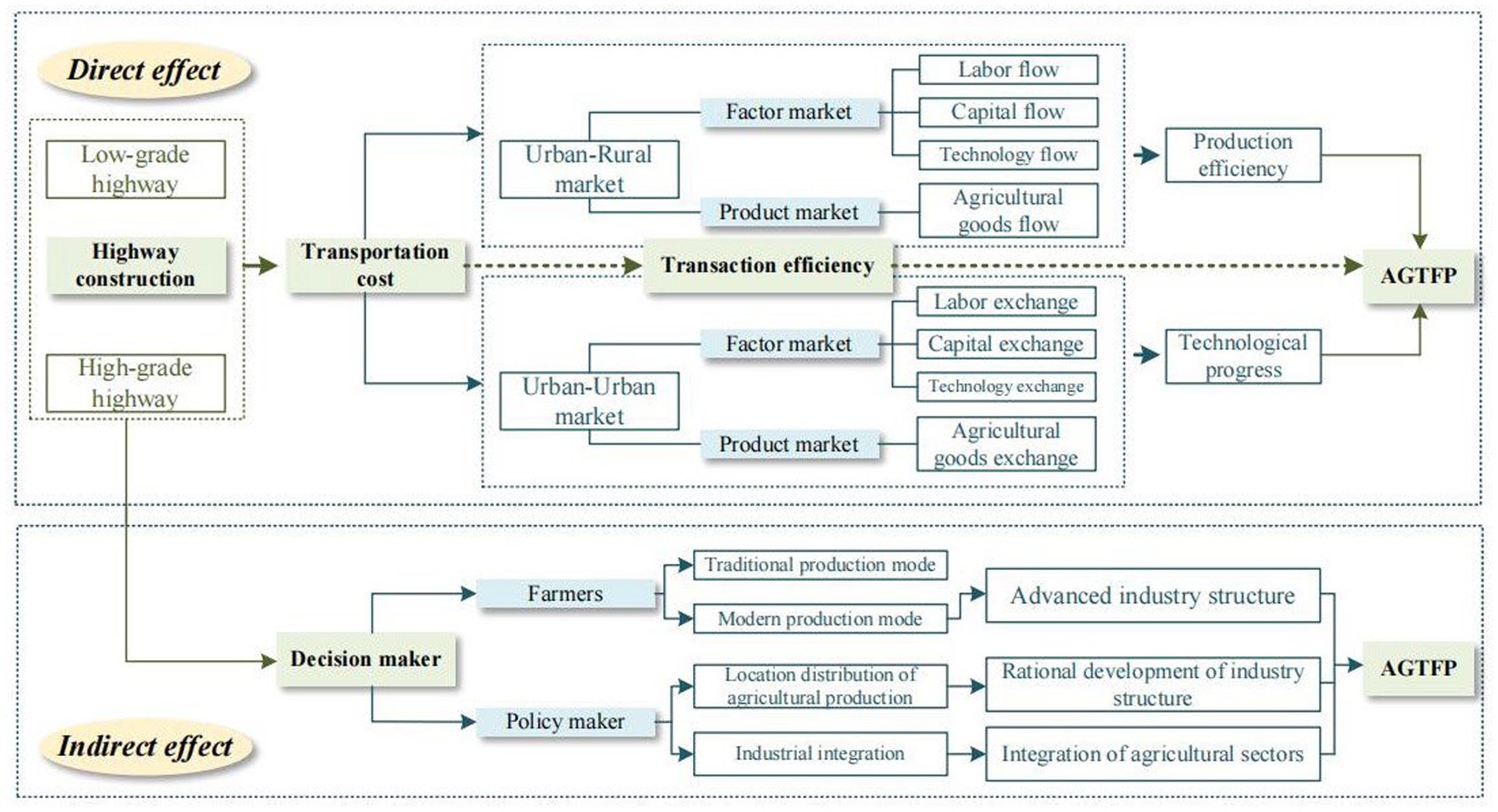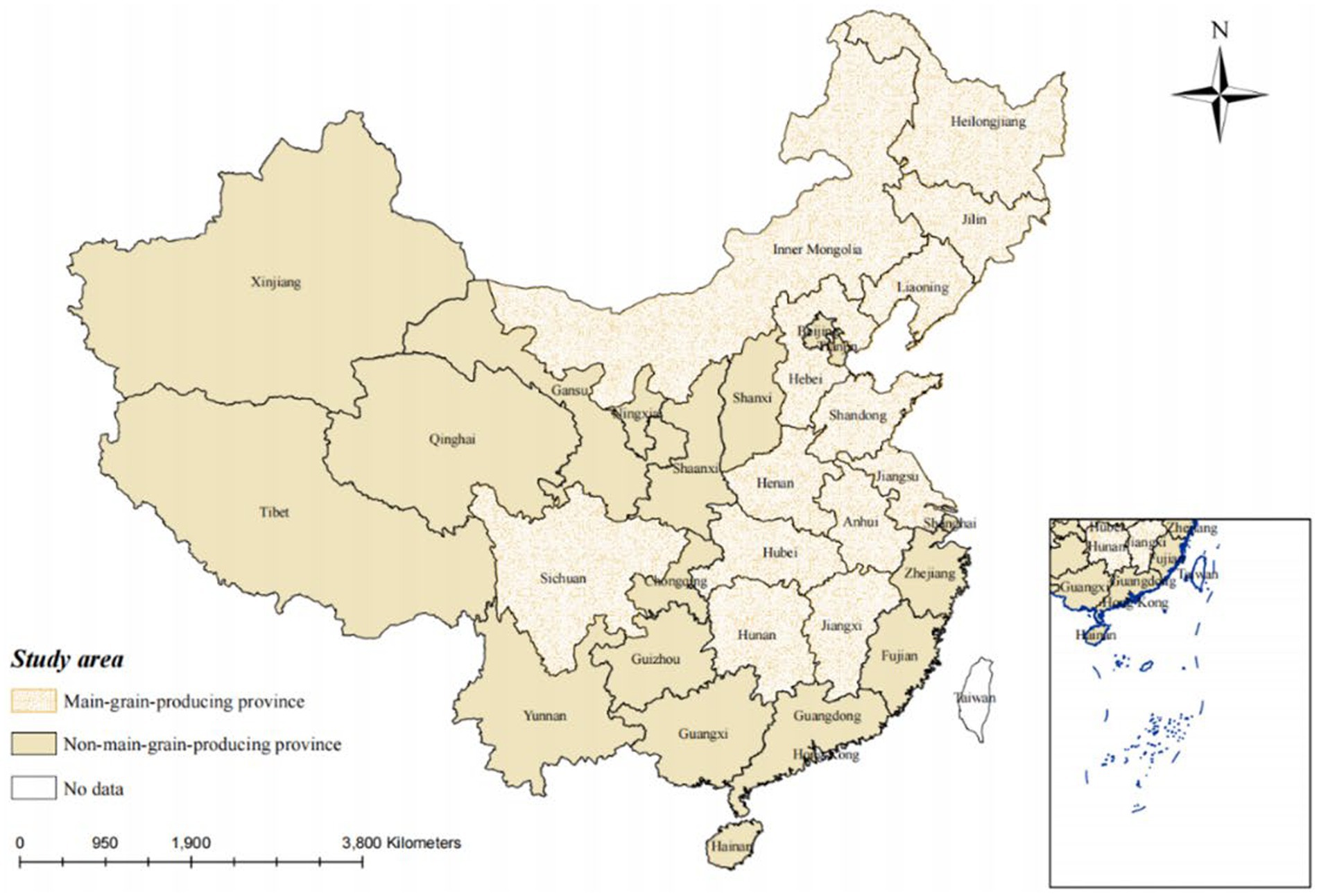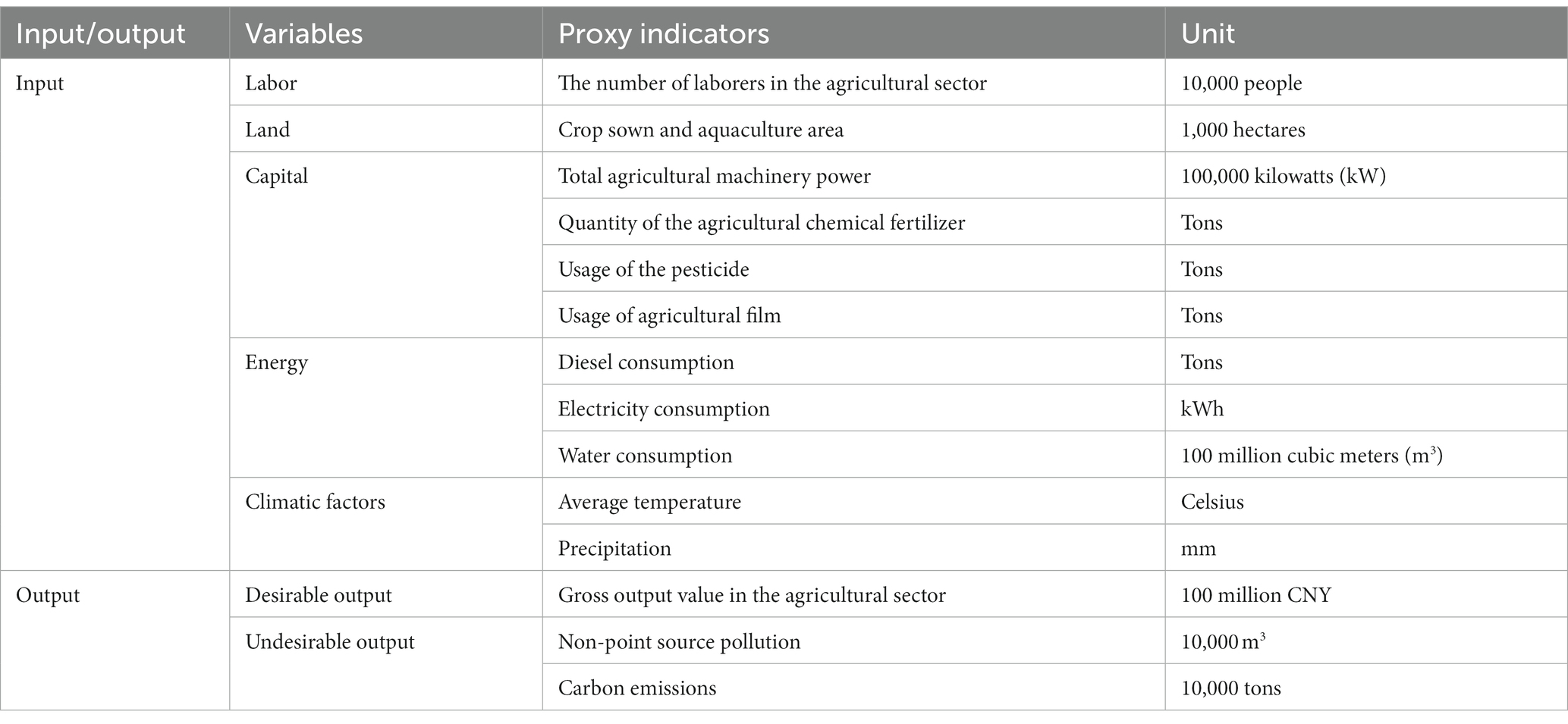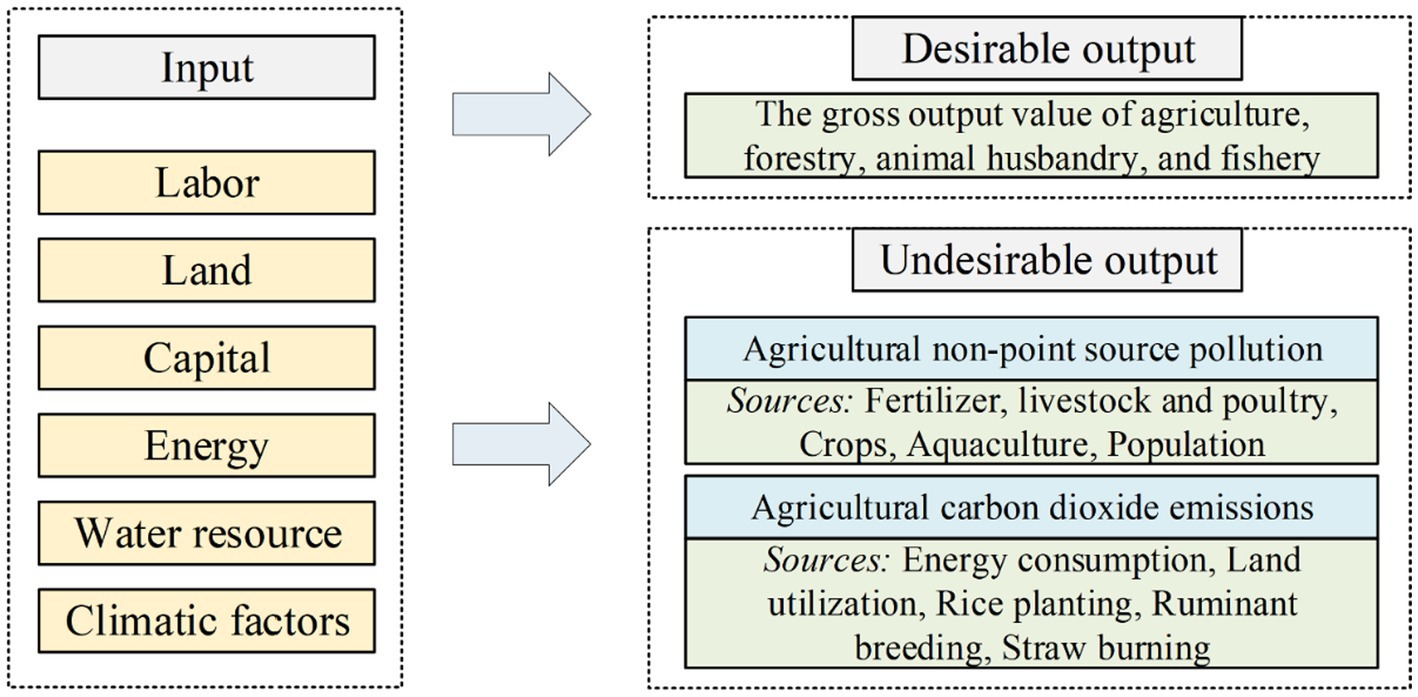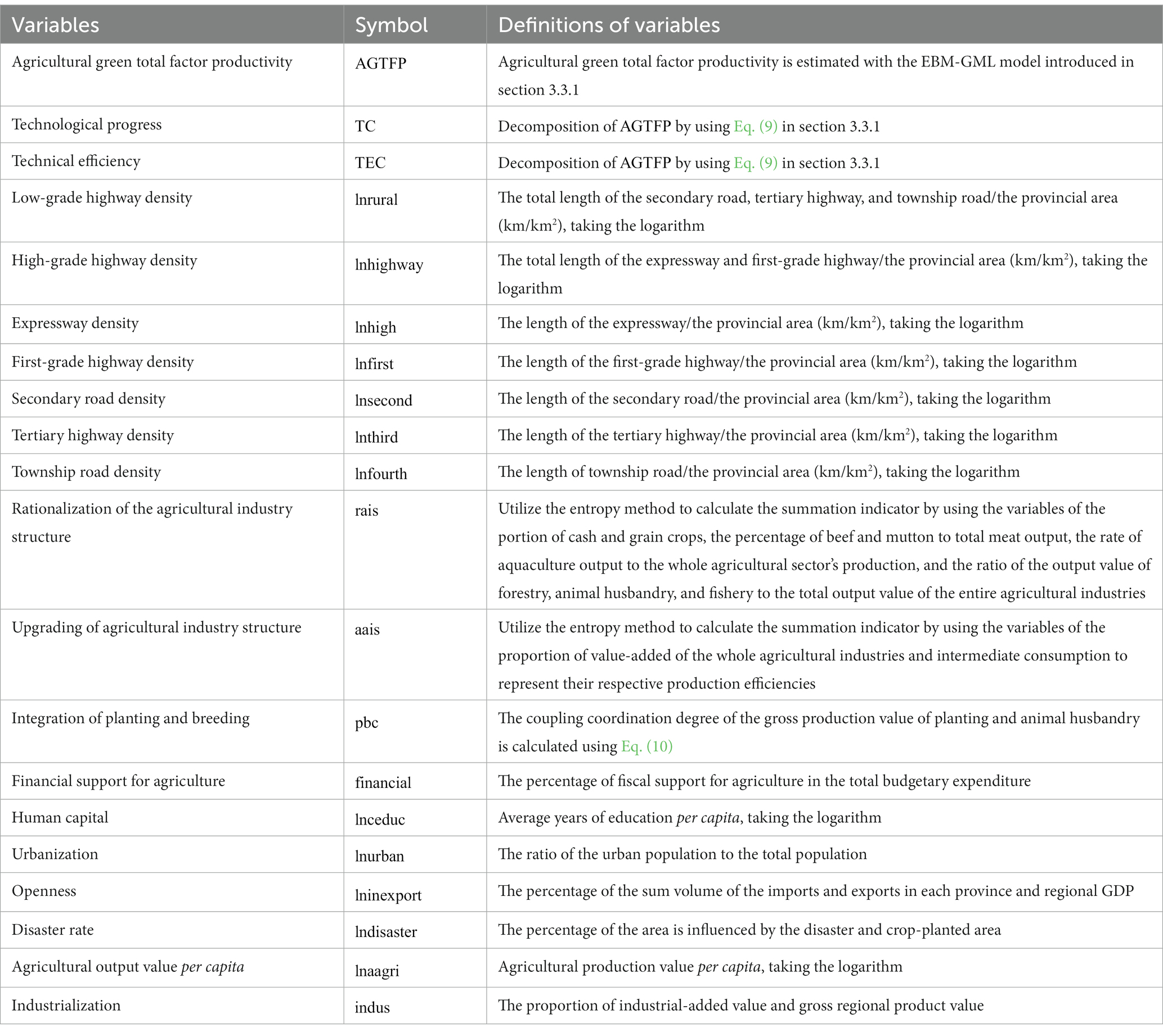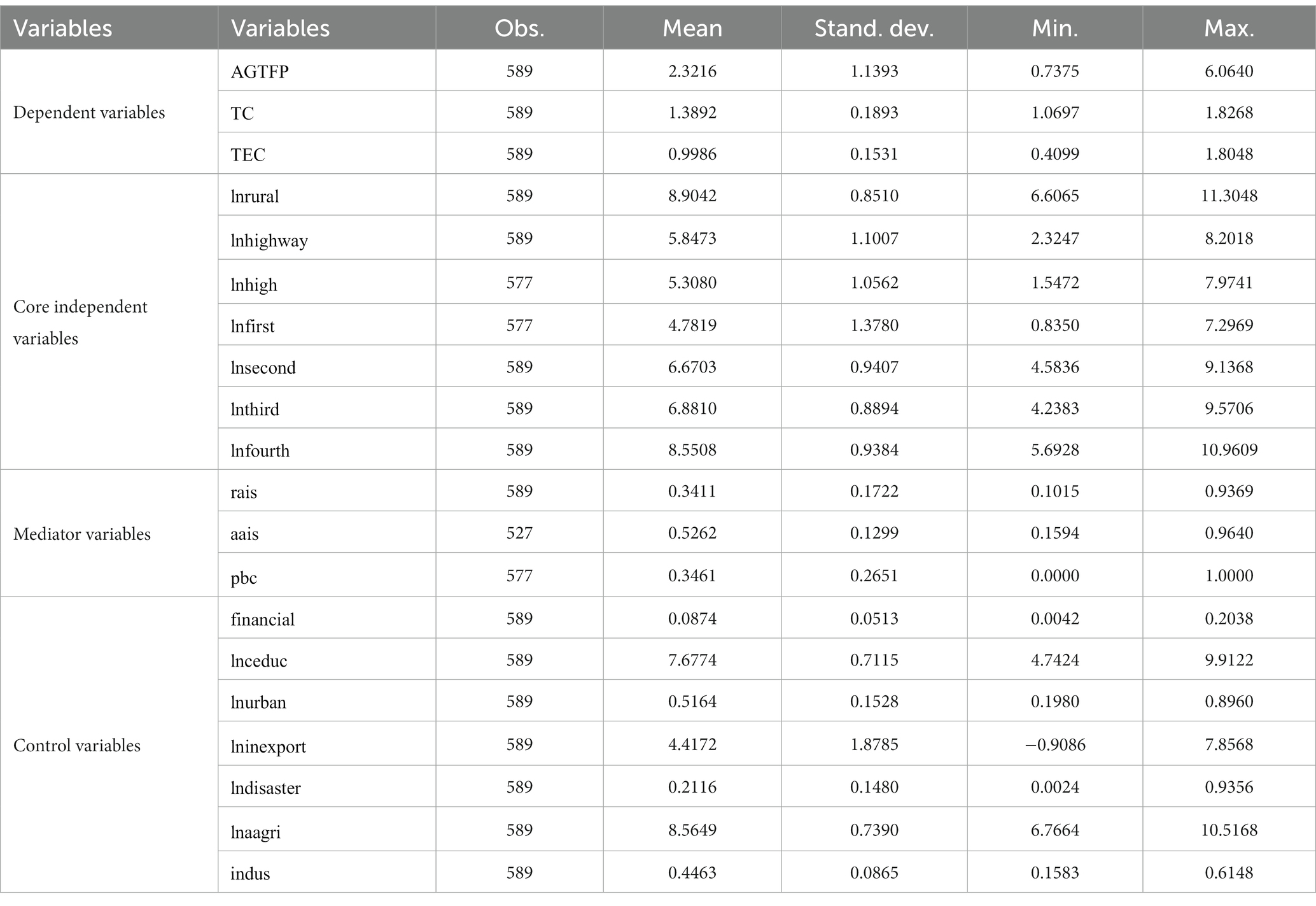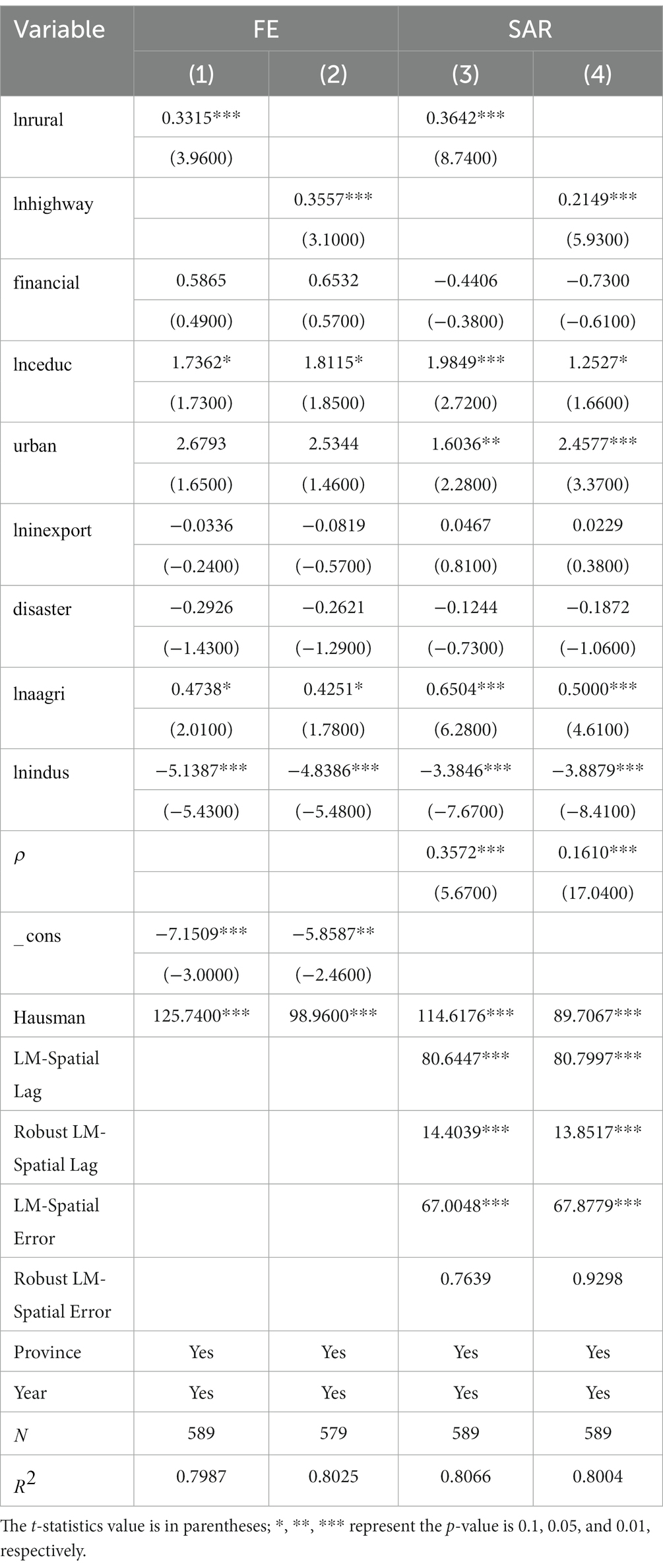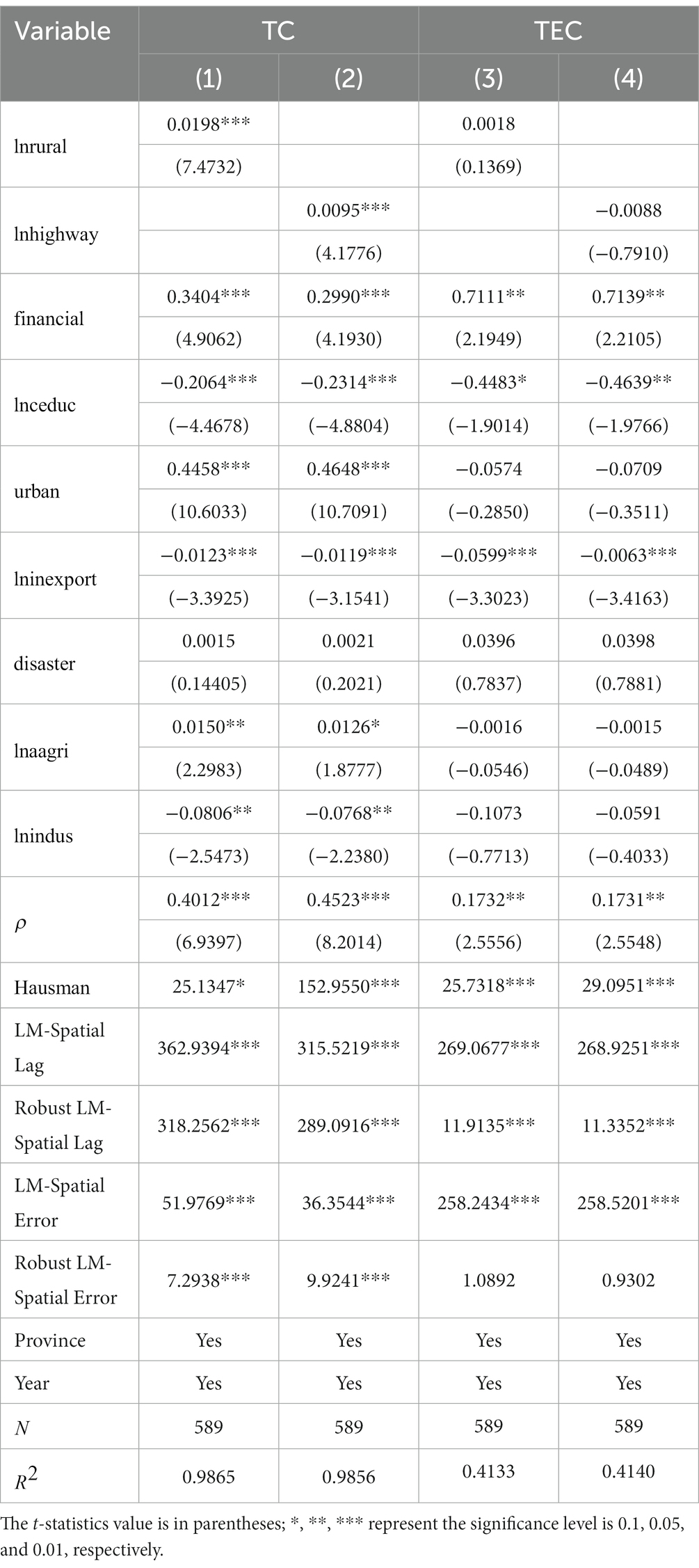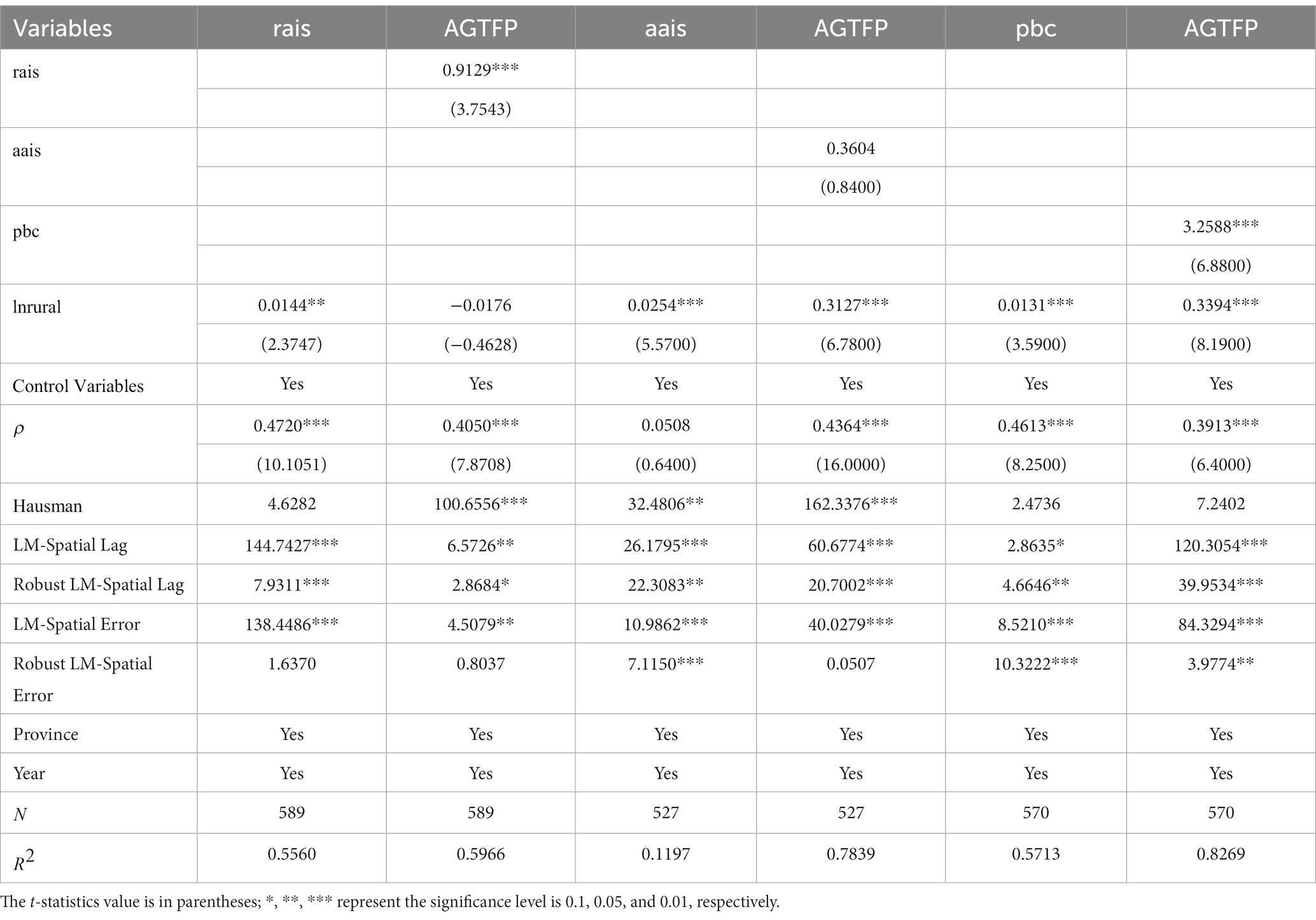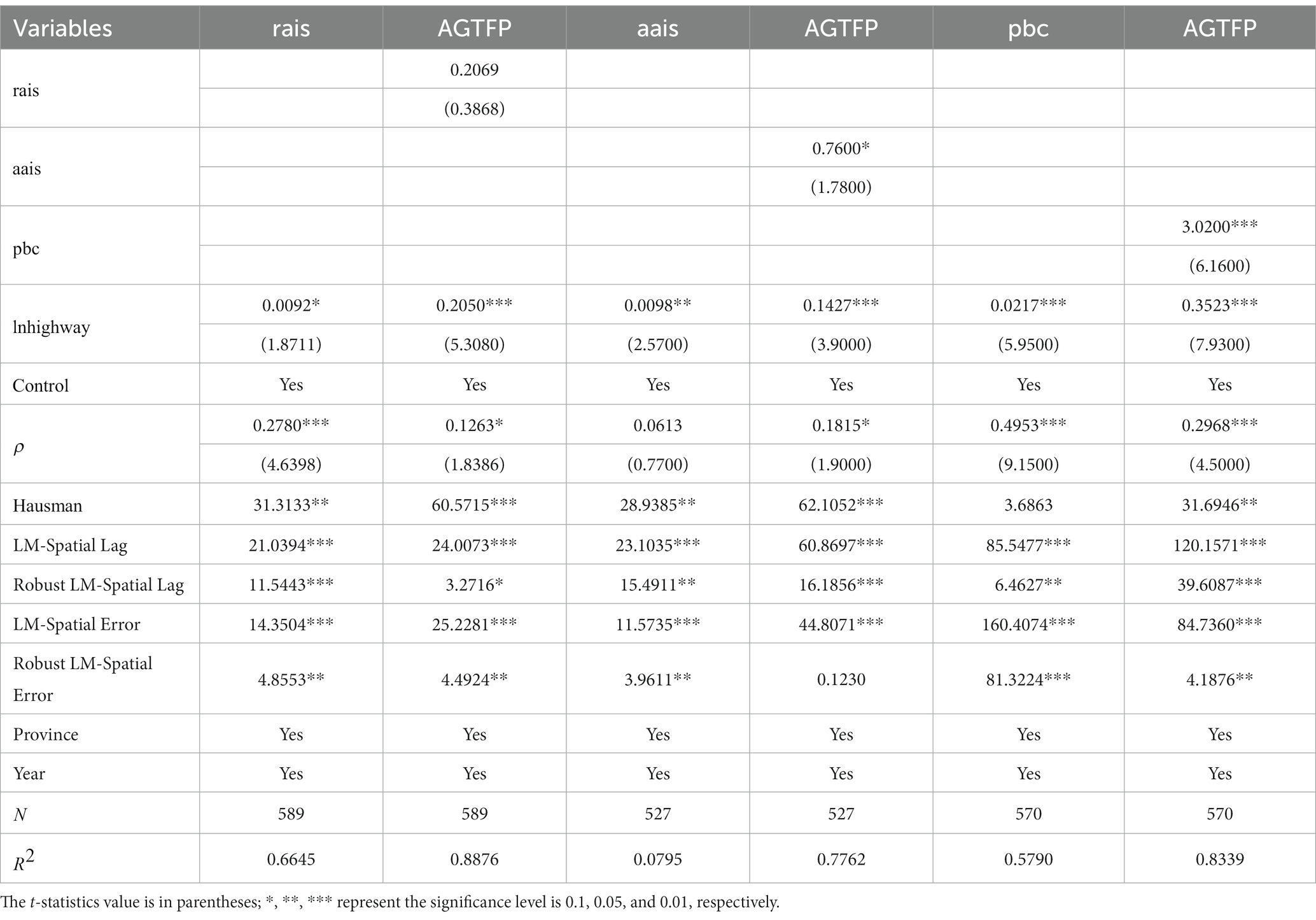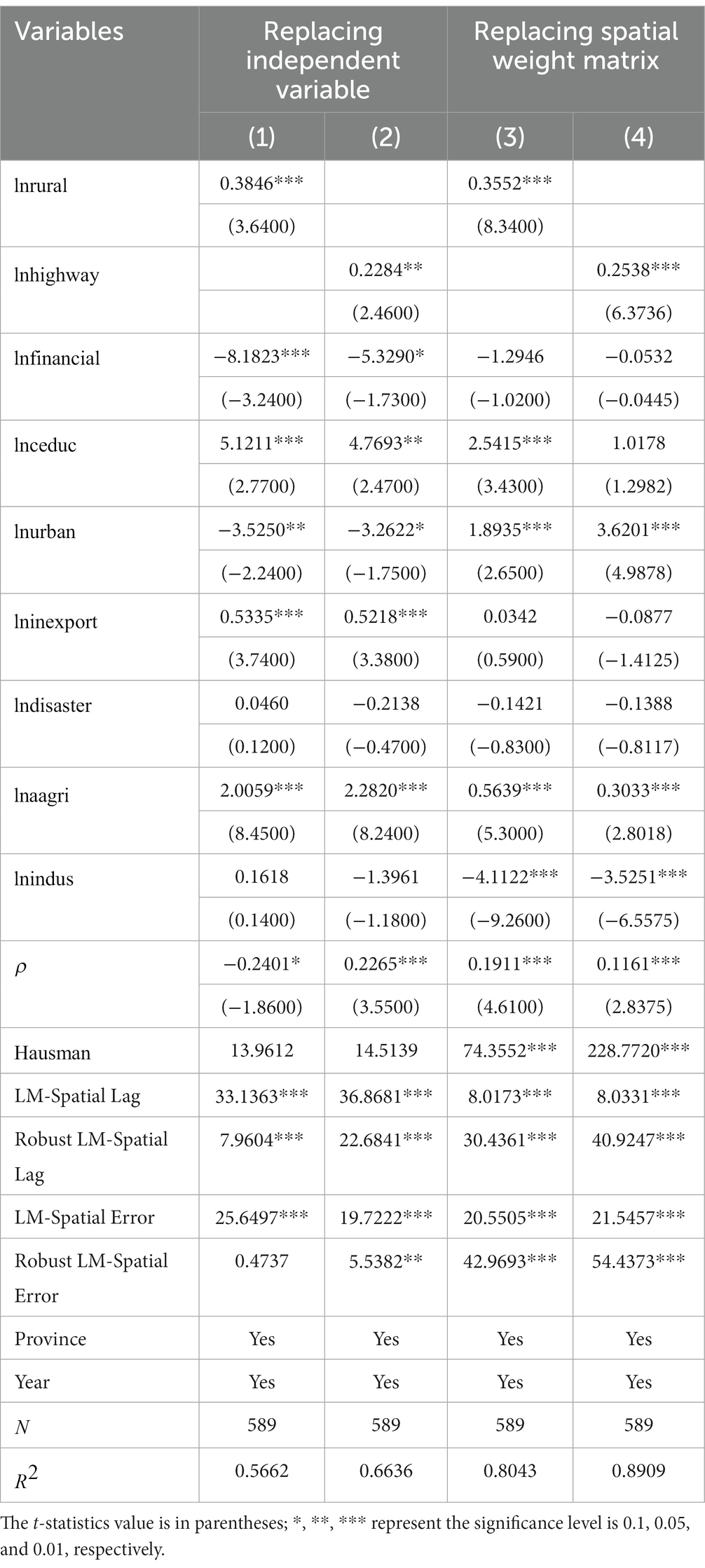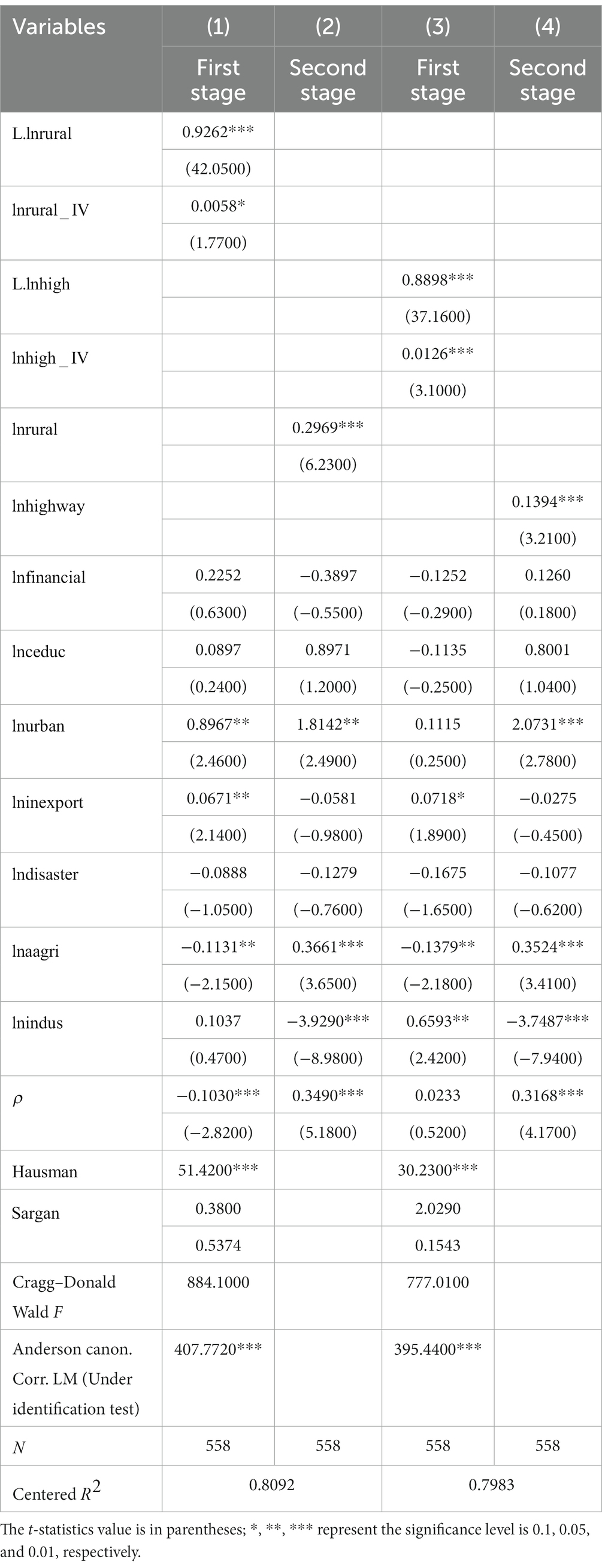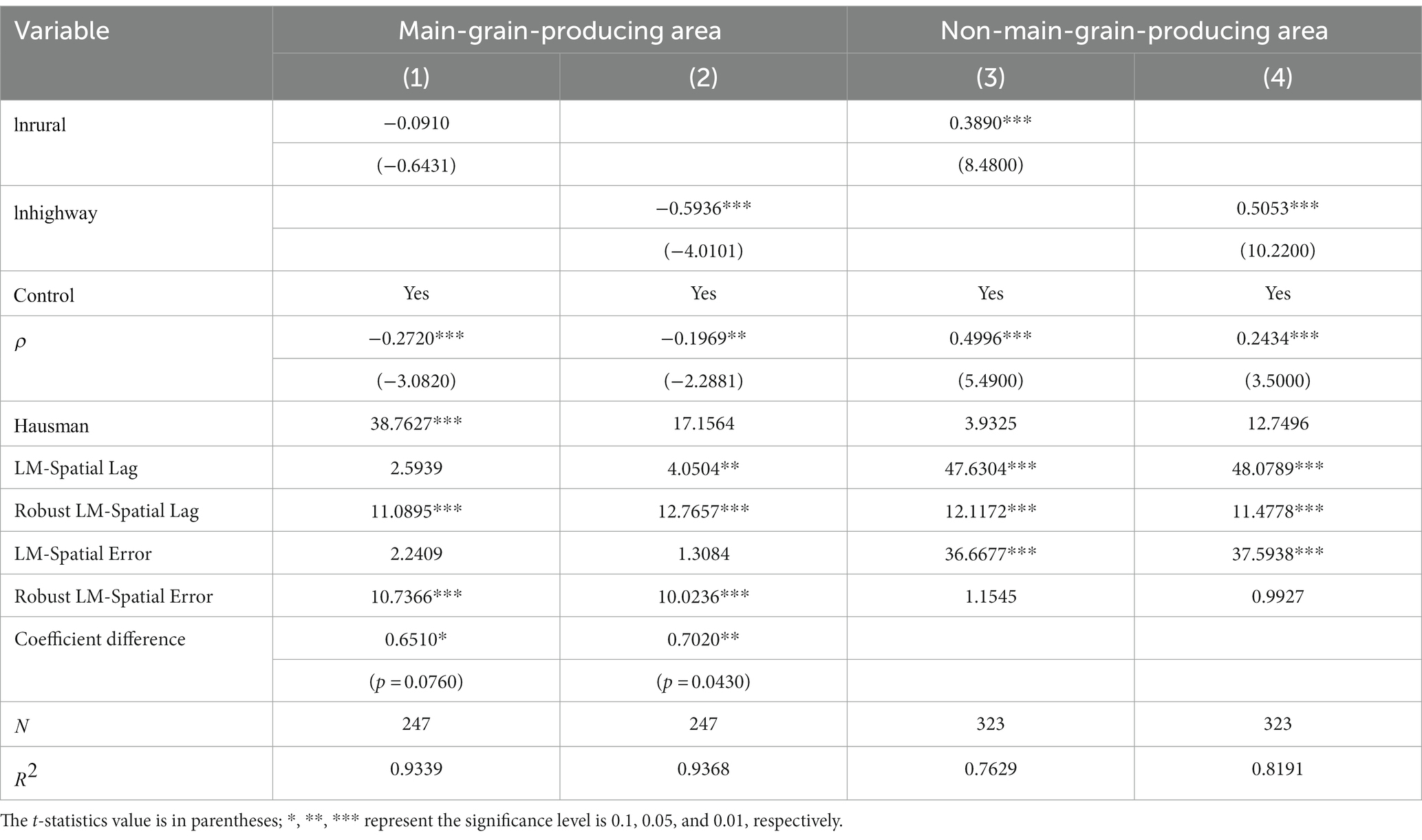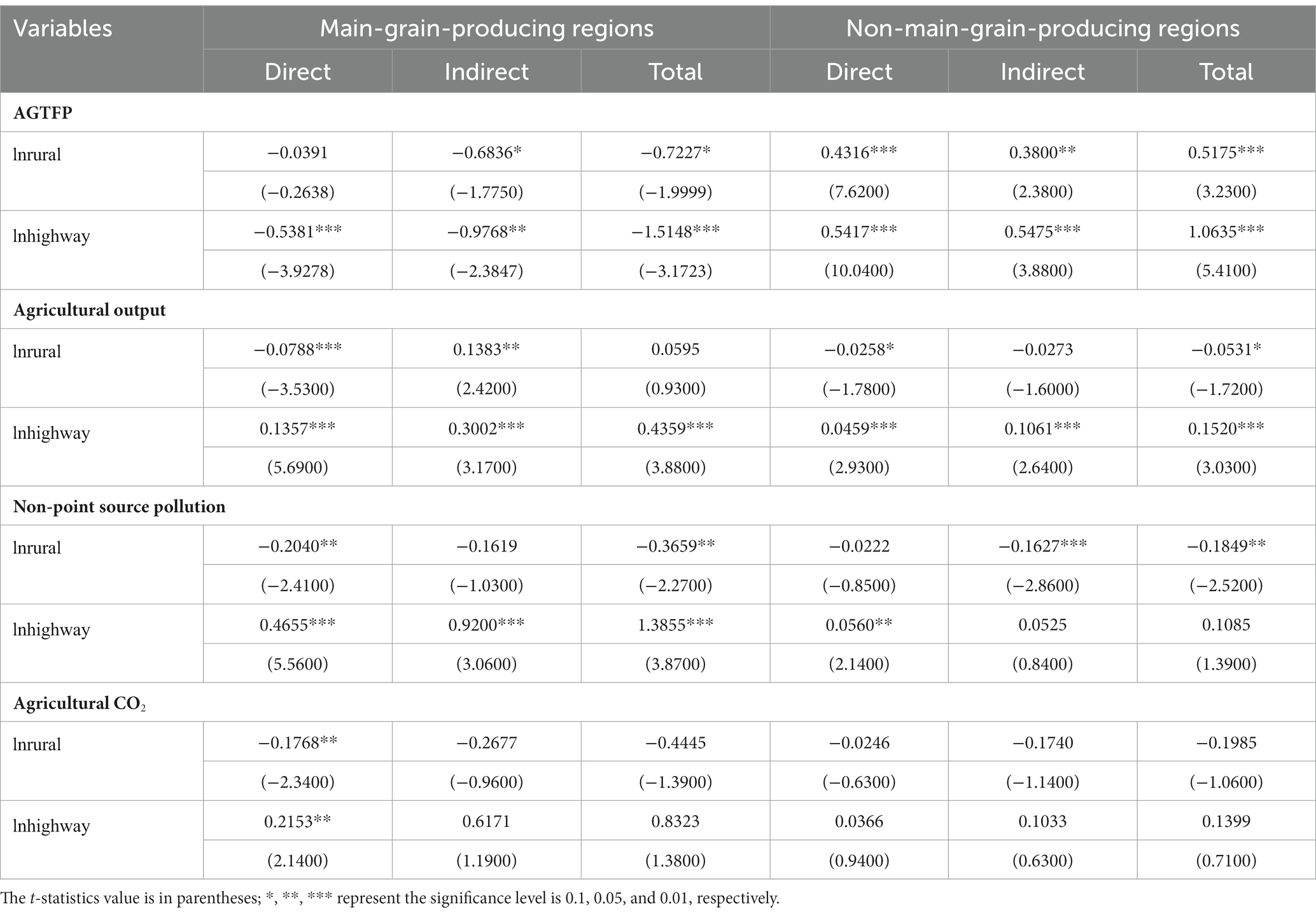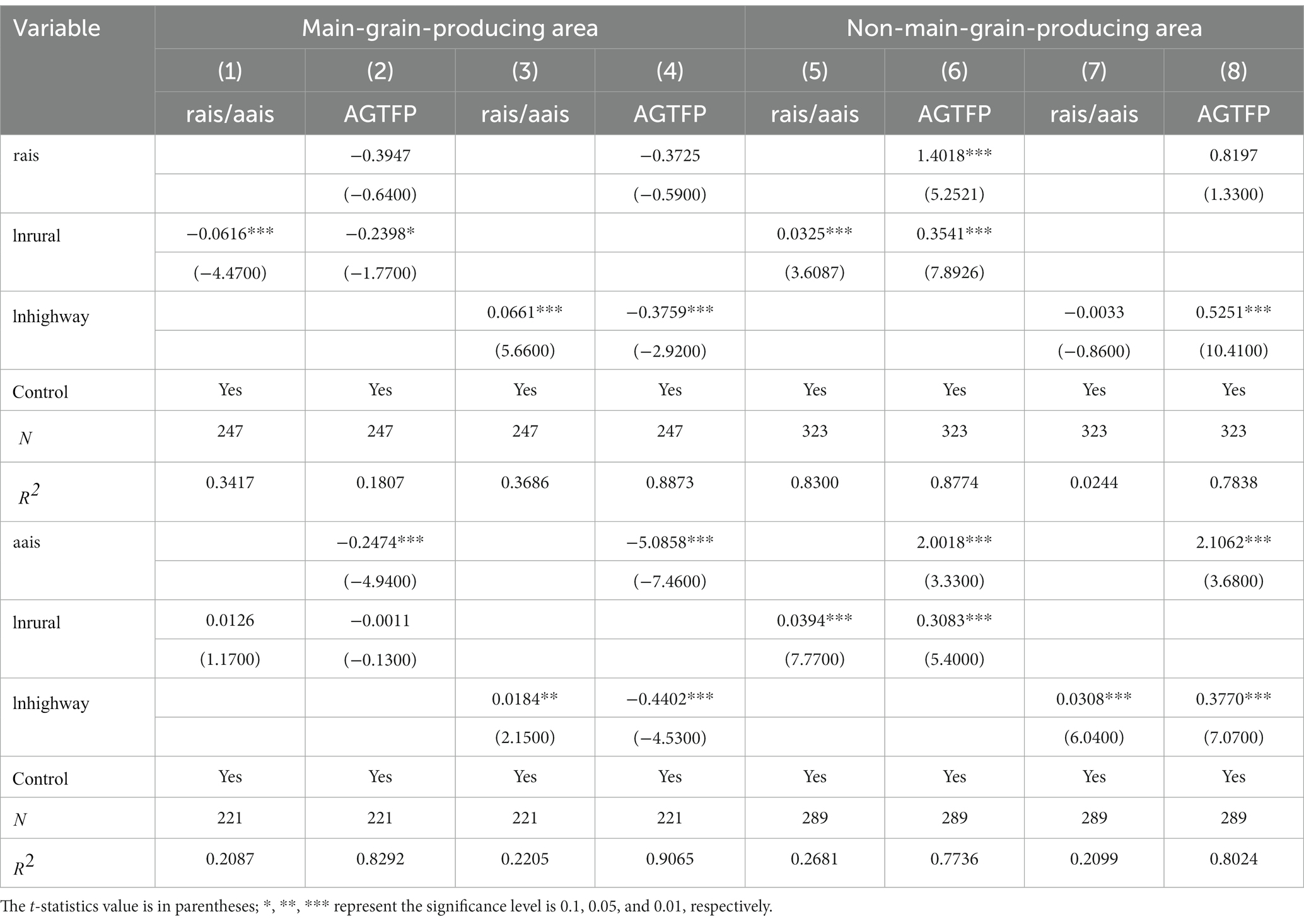- 1School of Economics and Management, Beijing Jiaotong University, Beijing, China
- 2School of Transportation Science and Engineering, Civil Aviation University of China, Tianjin, China
Highway construction is vital in agricultural production, directly influencing food security and public health. This study utilized the Epsilon-based measurement-global-Malmquist-model (EBM-GML) and the spatial econometrics model with 31 Chinese provinces’ panel data from 2002 to 2020 to investigate the impacts and the mechanisms of low-grade and high-grade highways on the agricultural green total factor productivity (
1 Introduction
Agriculture is the primary sector of the national economy, and its sustainable development is highly related to the citizens’ food security and economic growth (Fu and Zhang, 2022; Babu et al., 2023). Specifically, China’s agriculture provides food for 22% of the world’s population, with only 10% of the arable land worldwide (Chen et al., 2021), which is crucial in the global economy. China has made remarkable achievements in agricultural growth in the past 40 years, with an average annual growth rate of 4.6% (Gao et al., 2022). However, China’s agricultural development under the circumstance of high resource consumption for a long time caused severe waste and environmental pollution (Su et al., 2020; Koondhar et al., 2021), such as excessive fertilization, water pollution, which seriously restricts the agricultural green development (Chen et al., 2021; Liu et al., 2021). Moreover, these pollutants also account for a large proportion of the world’s pollution. For example, the ratio of China’s agricultural carbon emissions (CO2) in total volume worldwide was 17%, which was the world’s largest source in 2019 (Gao et al., 2022). Therefore, analyzing the measures to promote green production in China’s agriculture is extraordinarily urgent and significant for sustainable development worldwide and has become the focus of governments and academic circles (Song et al., 2022; Luo et al., 2023). Agricultural green total factor productivity ( ) is an indicator to measure the sustainability level of agricultural development, considering the economic output and environmental outputs simultaneously (Liu and Feng, 2019; Ye et al., 2023).
Many scholars have calculated the and explored the influencing factors (Chen et al., 2021; Liu et al., 2021). Generally, there were two kinds of methodology commonly used to calculate , which are data envelopment analysis ( ) and stochastic frontier analysis ( ) (Li and Yang, 2018). Compared with the method of , has the advantage of non-parameter estimates without setting the actual production function (Razzaq et al., 2019). Besides, the methodology of could consider multiple inputs and outputs simultaneously (Emrouznejad and Yang, 2018), so it was often combined with the Malmquist index to calculate agricultural production efficiency (Coelli and Rao, 2005; Tipi and Rehber, 2006; Rezitis, 2010). However, the traditional approaches are radial models, requiring the input and output to change in the same proportion. Besides, this method could only consider desired output, not include undesired parts. To overcome these problems, Tone (2001) built a non-radial slack-based measurement ( ) model to calculate efficiency. Many researchers used the SBM-DEA model to measure (Liu et al., 2020; Pishgar-Komleh et al., 2021). For example, Liu et al. (2020) estimated the eco-efficiency in the agricultural sector ( ) by utilizing the super- model in China from 1978 to 2017, and the results showed that the increased from 0.405 to 0.713, with an increase of around 76%.
The above agricultural productivity studies primarily utilized radial or non-radial measurements, which could overestimate or underestimate the efficiency improvements. Tone and Tsutsui (2010) constructed the epsilon-based measure ( ) model to consider the radial and non-radial characteristics comprehensively, which measures the efficiency more accurately (Wu et al., 2019). Then, this model was widely used in calculating the eco-efficiency of the city (Zhang Y.Z. et al., 2022), transportation carbon efficiency (Zhao et al., 2022), industrial (Wang and Wang, 2023), etc. Although the model has been utilized to calculate the efficiency in various research fields, it has rarely been used in measuring the efficiency in the agricultural sector.
Expect measuring , the influencing factors analysis of it is another research question that scholars have been widely concerned about. Some research proposed that technological progress is an essential factor in promoting (Bachewe et al., 2018; He et al., 2021; Shi et al., 2023). However, Hamid et al. (2023) proposed that technical efficiency restricts the . Therefore, strengthening the research inputs in agricultural science and technology is essential for promoting the (Liu et al., 2021). Additionally, some researchers found that the government is critical in improving agricultural production efficiency. Xu L. Y. et al. (2023) proposed that financial support helps raise the . However, Deng et al. (2023) found that fiscal expenditures significantly increased the mainly through enhancing rural infrastructure. Meanwhile, the environmental regulation proposed by the government is also effective in promoting the (Liu Z. et al., 2023; Liu G. J. et al., 2023; Tang et al., 2023). Moreover, it is also essential for the government to help transform and upgrade the industrial structure in the agricultural sector to solve the factor misallocation problem for improving the (Lei et al., 2023). In addition, some socioeconomic factors are also considered the critical factors influencing the , such as urbanization, human capital, digital development level, etc. (Fu and Zhang, 2022; Shen et al., 2022; Li L. et al., 2023; Li X. H. et al., 2023).
Moreover, some researchers proposed that transportation development is vital for agricultural production (Limi, 2022). First, highway construction helps agricultural production materials flow into rural areas, such as seeds, chemical fertilizers, pesticides, etc., thereby directly promoting agricultural production efficiency (Gollin and Rogerson, 2014; Aggarwal, 2018; Shamdasani, 2021). Second, highway construction can also encourage agricultural technicians to come to rural areas for guidance, promoting the level of technology (Teng and Li, 2020). Thirdly, highway construction also helps surplus rural labor transfer to urban areas, improving agricultural productivity (Liu et al., 2015; Zhang et al., 2021). However, highway construction also adversely affects agricultural production, such as land fragmentation (Bacior and Prus, 2018). Li et al. (2015) proposed that road expansion brought about the total carbon stock loss in the Democratic Republic of Congo, with 316 Tgc. Zhou et al. (2021) discovered that rural road construction negatively affects the environmental sustainability in China’s regional agriculture due to the overuse of fertilizers. Therefore, the influence of highway construction on the is uncertain and deserves further exploration.
The current literature has fully explored the and its influencing factors, which gives a deep understanding of the and provides some practical policy implications for the sustainable development of agriculture. However, this kind of research still has some limitations. For example, based on the heterogeneity characteristics of transportation, limited literature has analyzed the influence mechanism of different grades of transport on agricultural production. Besides regional heterogeneity in the natural environment and economic development level, the highway’s impact on agricultural production is heterogeneous; however, there is limited research analyzing the different effects among various regions. This study’s theoretical contribution mainly contains three aspects.
First, analyze the heterogenous effect and mechanism of the low-grade and high-grade highway on the . Although existing literature has attached importance to the influence of highway construction on agricultural production (Tong et al., 2013; Aggarwal, 2018; Shamdasani, 2021), there is limited study on its effect on . Meanwhile, there is a lack of research to analyze the heterogeneous influence and mechanism of the different grades of highways on agricultural production. The path of the effect of low-grade and high-grade highways on agriculture is different. The low-grade road is an important channel to connect the city and countryside, directly affecting agricultural production. Meanwhile, the high-grade road indirectly affects agricultural production by strengthening regional correlations. Thus, it is essential to distinguish each grade highway’s influence and mechanism on the .
Second, empirically analyzing the spillover effects of the highway construction on the . Previous literature explored the influence of rural road and expressway connectivity on the local area’s agricultural production (Aggarwal, 2018; Teng and Li, 2020), but there is a lack of analysis of the impacts of highway construction on the other areas. Generally, highway construction aims to shorten the distance and strengthen the connections between regions; the increased communication is likely to stimulate the spatial impact on the adjacent areas and is worth analyzing. Therefore, we constructed the spatial econometrics model to investigate highway construction’s direct and spillover effects on .
Thirdly, we compared the heterogenous effect of highway construction on the in the main-grain-producing and non-main-grain-producing areas. Existing literature mainly focused on the impact of highway construction on agricultural production in the main-grain-producing area (Luo et al., 2020; Liu and Xiao, 2021), with less attention on the non-main-grain-producing regions and a lack of comparative analysis between them. Given the differences in natural conditions and production tasks in the various areas, it is also necessary to compare the heterogeneous effect of highway construction on each production area for formulating the targeted policy for different regions.
The specific research objectives of this study were to explore the direct and spillover effects of different highway construction on the sustainable development of agriculture in China. Specifically, we calculated by utilizing the EBM-GML model to measure the sustainability level of agriculture, which has consistency with the method in the most current studies. Firstly, we theoretically analyzed the different influence mechanisms of low-grade and high-grade highways on the . Then, we utilized the spatial econometrics model to analyze the direct and spillover effect of highway construction on . Moreover, we examined the mechanism of highway construction on by using the mediation effect model. Finally, we explored the heterogeneous impacts on the various producing areas. This study provides valuable empirical evidence for the Chinese government to conduct a rational transportation plan to realize sustainable agricultural development. Meanwhile, the heterogeneity analysis of in different regions could also provide significant references for developing countries in various stages of agricultural development.
2 Mechanism analysis
2.1 Highway construction and AGTFP
2.1.1 Low-grade highway construction and AGTFP
Generally, constructing transportation infrastructure is essential for reducing transportation costs and promoting market transaction efficiency (Holl, 2016; Ghani et al., 2017). The low-grade highway is an important channel connecting urban and rural markets and reducing transportation costs, which promotes transaction efficiency in their factor and product markets to a certain extent (Dorosh et al., 2012; Aggarwal, 2018).
For the factor market, low-grade highway construction provides convenience for labor, capital, and technology flow in urban and rural markets. First, constructing low-grade roads promotes the surplus rural labor flow into the urban industrial sector, thereby improving agricultural production efficiency (Lewis, 1954). Then, the reduction of transaction costs brought about by the low-grade highway construction also promotes the inflow of capital into the agricultural sector and directly invests in agricultural production to improve agricultural technical efficiency. Moreover, the low-grade highways also greatly facilitate agricultural technicians to guide the farmers (Luo and Peng, 2016; Teng and Li, 2020), thus improving production technology levels.
For the product market, the low-grade roads have promoted the flow of industrial products, such as fertilizers, pesticides, seeds, etc., into the agricultural sector, directly encouraging agricultural production efficiency (Limi, 2022). Besides, constructing low-grade highways reduces the intermediate loss of agricultural products transported to the city, which expands the agricultural products market (Gollin and Rogerson, 2014) and promotes its production efficiency.
Overall, low-grade highway construction has improved agricultural production efficiency and technical level by promoting the flow of factors and products, which could further boost the . Therefore, we proposed the Hypothesis 1:
Hypothesis 1 (H1): Low-grade highway construction could promote the AGTFP
2.1.2 High-grade highway construction and AGTFP
The construction of high-grade highways promotes the connection between cities, improving the transaction efficiency of a broader range of factor and product markets, significantly impacting . For the factor market, constructing a high-grade highway promotes the mutual exchange of labor, capital, and technology among cities, stimulating the optimal factor allocation among regions (Morando, 2023). For the product market, the construction of high-grade highways promotes the trade of agricultural products between cities, which helps each area carry out specialized production according to its comparative advantages (Adamopoulos, 2011), thus improving agricultural production efficiency. Therefore, strengthening high-grade highway construction could promote the optimal allocation of factors and product structure between regions to improve agricultural production efficiency and achieve efficient agricultural production. Thus, we proposed Hypothesis 2.
Hypothesis 2 (H2): High-grade highway construction could promote the AGTFP
The high-grade highway construction has also increased regional communication and produced a spatial spillover effect. First, high-grade highways facilitate people’s flow, transferring knowledge and technology from developed regions to surrounding areas (Shamdasani, 2021). The reason is that local farmers could conveniently move to developed areas for agricultural technology training (Aggarwal, 2018). Then, the construction of high-grade highways will also help more advanced agricultural production materials flow into surrounding areas, thereby promoting the overall sustainable development of agriculture. Thus, we proposed Hypothesis 3.
Hypothesis 3 (H3): High-grade highway construction could exert spatial spillover effects on the adjacent areas.
2.2 Highway construction, agricultural industry structure, and the AGTFP
The reduction of transportation costs caused by highway construction also impacts the production decision-making and planning of farmers and policymakers and then has a specific impact on .
For farmers, the decline in transportation costs will affect their decision to adopt modern agricultural production modes (Damania et al., 2017; Shamdasani, 2021). On the one hand, there are some costs of converting from traditional to modern agricultural production mode, including purchasing agricultural equipment and learning new technologies. On the other hand, modern agriculture will improve production efficiency to a certain extent, such as mechanization production, thus increasing farmers’ income. With the reduction of transportation costs, the conversion cost of farmers will also decrease, which will encourage farmers to adopt modern agricultural production modes. Modern agriculture could promote the reduction of intermediate consumption, realize the upgrading of the agricultural industry structure, and affect production efficiency. Therefore, we proposed Hypothesis 4a.
Hypothesis 4a (H4a): Highway construction could promote AGTFP by stimulating the upgrade development of the agricultural industry structure.
Policy planners aim to maximize the benefits of the whole region’s agricultural sector. Regional agricultural development costs include production costs of each product and transportation costs to reach the market (Jacoby, 2000; Helmstädter, 2010). Due to the characteristics of each agricultural product, its transportation cost has specific differences. The continuous improvement of highway construction also exerted heterogeneity in reducing the transportation costs of various products. Therefore, policy planners need to change their production layout based on the extent of the reduction of transportation costs for different agricultural products to adjust the distance of each product to the market to maximize the overall benefit (Rivera-Padilla, 2020). Adjusting the agricultural industry structure layout could bring about optimal resource allocation in the spatial scope and improve agricultural production efficiency. Thus, we proposed Hypothesis 4b.
Hypothesis 4b (H4b): Highway construction could promote AGTFP by stimulating the rationalization of agricultural industry structure.
Policymakers also usually consider how to promote the integration of various industrial sectors to achieve overall benefits. Highway construction has enabled the integration of various agricultural sectors (Huang et al., 2020). Before integrated development, highway construction reduced the communication cost between different industrial sectors and improved their integration efficiency. During the integrated development, highway construction could not only strengthen the connection of the entire industrial chain and reduce uncertainty but also promote the sharing of resources among various industrial sectors to reduce agricultural production costs and promote efficiency (Jiang et al., 2023). Therefore, we proposed the Hypothesis 4c.
Hypothesis 4c (H4c): Highway construction could promote the AGTFP by promoting the integrated development of agricultural industry sectors.
2.3 Heterogenous effects of highway construction on the AGTFP
There are five temperature zones in mainland China, and it has different agricultural production environments. Meanwhile, China’s economic development gap exists between the North-South and the East-West (Yin et al., 2022). Therefore, the influence of highway construction on agricultural production in various areas will also be different. According to the natural production conditions in China, the government categorized 13 provinces as the main-grain-producing regions. Thus, because of its natural environment, which is suitable for agricultural production, this area undertakes more grain production tasks (Zhang et al., 2021). For this area, highway construction has promoted the agricultural machinery operating cross-region, which has realized large-scale agricultural production and increased total grain output value (Luo et al., 2018). However, large-scale production activities will produce much environmental pollution in this area, which inhibits (Zhang et al., 2019).
Meanwhile, because most main-grain-producing areas have a relatively low economic development level, the negative environmental output of their growth will vastly exceed the economic effect, which will have a side effect on the local . However, highway construction will bring in more agricultural production resources for non-main-grain-producing areas, which could help them expand the production scale, and it is also conducive to improving their technology due to their developed economic status, thereby promoting the continuous rise of the . Thus, we proposed Hypothesis 5.
Hypothesis 5 (H5): Highway construction exerts a heterogenous effect on the AGTFP in different production areas.
According to the analysis above, we drew the mechanism analysis framework in Figure 1.
3 Method and variables
3.1 Study area
The scope of this research is 31 provinces in mainland China. At the same time, China has divided 13 main-grain-producing provinces to adapt to the new grain production and distribution pattern changes so that these areas can take advantage of their geographical resources. Therefore, this study also compared the heterogeneity of highway construction’s impact on the in different regions. Figure 2 presents the specific division of the study area.
3.2 Econometric model
3.2.1 Fixed-effect regression model
To investigate the relationship between highway construction and , we first constructed the fixed-effect regression model by taking the as the dependent variables, highway construction as the core independent variable, and financial support, urbanization, and other variables directly impact the as the control variables. Then, we utilized the fixed effect regression model to analyze the impacts by simultaneously controlling the individual (province) fixed and time (year) fixed effects. We first fixed some regional variables that do not change with time, such as regional farming culture, terrain characteristics, etc. These variables are difficult to measure and do not vary over time, so we controlled the individual effects. Then, we added the time effect to fix the influence of factors that change over time, such as macroeconomic situations and national policy shocks. Controlling the above two effects could reduce the missing variable bias, and the model is represented as Eq. (1).
where is the dependent variable, which denotes the in province , year ; represents the highway construction; is the vector of control variables; reflects the influencing coefficients of each factor; and are the individual and time-fixed effects; reflects the error term.
3.2.2 Spatial econometrics model
We utilized spatial econometrics to explore the impacts of highway construction on the by considering the spillover effect. Generally, the spatial Durbin model ( ) is the general form of the spatial econometrics model, including the spatial interaction of dependent and independent effects simultaneously (LeSage and Pace, 2008). When the model only exists the spatial lag effect of the dependent variable, it will transform into the spatial autoregression model ( ). Moreover, if the model only has the spatial error effect, it will change into the spatial error model ( ). The model is represented as Eq. (2):
where is the spatial weight matrix reflecting the spatial correlations among regions; and represent spatial lag effect coefficients of and highway construction, respectively.
Two kinds of spatial weight matrices were utilized in this paper. The first is the geographic distance matrix ( ), with the element representing the geographical distance between the two provinces. According to Liu and Lin (2019), the distance is calculated by the latitude and longitude of the provincial capital city. The second is the economic distance matrix ( ). Based on Cai et al. (2022), the economic distance is calculated by the per capital GDP gap between two provinces.
In addition, Elhorst (2010) proposed that the model can be applied to decompose the spillover effect in the spatial econometrics model. Eq. (3) shows that we could decompose the coefficients of each factor into direct and indirect effects.
Then, the partial derivatives of the -th independent variable are shown in Eq. (4):
When the explanatory variables in Eq. (3) change, it will drive the explained variable change, generate a direct effect, and affect the dependent variables of other units to exert a spillover effect.
3.2.3 Mediation effect model
The previous discussion of the mechanism of highway construction may affect the by upgrading the agricultural industry structure, promoting the rationalization of the agricultural industry structure, and integrating agricultural sectors. To test the mediation effects, we constructed the following models referring to Baron and Kenny (1986) and Gao et al. (2023) to investigate the mechanism of the influence of highway construction on the carefully.
Considering the inter-regional linkages brought about by the highway construction, it may exert a spillover effect on the inter-regional agricultural industrial structure. Therefore, we added the spatial lag variable of mediation variables in the Eq. (5) to construct a spatial econometric model. is the mediation variable, is the spatial lag variable of . The coefficient in Eq. (2) illustrates the total effect of the highway construction on the , and the coefficient in Eq. (5) means the effect of highway construction on the mediation variable. When the coefficient is significant, indicating that highway construction promotes the mediation effect and vice versa. After that, we put the mediation variable, core independent variable, and their spatial lag variables in the Eq. (6) while considering the spillover effects caused by the highway construction. The coefficient in the Eq. (6) is the direct effect of highway construction on the . The coefficients in Eq. (6) represents the coefficient of the mediating effect. When the coefficients , and are significantly positive, representing that a mediation effect exists.
3.3 Variables selection
3.3.1 Dependent variable
Generally, DEA is a kind of methodology for assessing efficiency with multiple inputs and outputs. Charnes et al. (1978) first constructed the CCR DEA model with a fixed-scale returns assumption based on the concept of boundary proposed by Farrell (1957). Then, Banker et al. (1984) extended the premises to reveal a BCC model to calculate technical and scale efficiency. However, CCR and BCC models are radial DEA, ignoring non-radial slacks. Tone (2001) utilized a difference variable to measure the slack in the input and output and a scalar in the non-radial estimation methods called the slack-based measurement ( ) method. However, this model failed to consider the parts with the same radial proportions. To solve these problems, Tone and Tsutsui (2010) constructed the method of , which integrated the radial and non-radial parts of the distance function and could reflect the ratio of objective and actual value and the difference between various inputs and outputs simultaneously. The development path of DEA is presented in Figure 3.
Meanwhile, considering the agricultural sector’s long cycle and continuous production process, we utilized the global Malmquist Luenberger ( ) to calculate the . The Malmquist index was calculated to represent the dynamic productivity during one period (Malmquist, 1953). Combined with the DEA model, this index was set to represent the changing productivity trend over time (Färe et al., 1992). However, the ML index is limited to noncircular geometric averages and linear programming infeasibility. Thus, Pastor and Lovell (2005) employed the GML index to solve this problem. Therefore, we measured the by constructing the EBM-GML model using 31 provincial data in China from 2001 to 2020. The detailed calculation process is as follows:
Step 1: Applying the EBM method to calculate the agricultural green production efficiency. The Eq. (7) is:
where reflects the value of green production efficiency; , , and represent the matrices of the input, desirable output, and undesirable output, respectively; and are the parameters of the radial part; , , and denote the slack-based variable of the related inputs or outputs; is the weight; , , and represent the relative weight of , , and ; , , and are the weight of the non-radial part.
Step 2: Calculating the index, which is shown in Eq. (8):
where represents the change rate of the green production efficiency for each province. And we could get the according to the global baseline production possibilities set. In particular, indicates the improvement of the green production situation, and means the deterioration of the green production situation. Then, we decomposed the index into the combination of the global production technology set with the index according to Oh (2010), and the formula is presented as follows:
where denotes the technological progress, represents the technical efficiency.
As for the indicators for measuring , there are some differences among the current studies. Most researchers selected land, labor, and capital as the input variables (Deng et al., 2023; Luo et al., 2023), which are the traditional production factors. In particular, the machinery is commonly considered as the capital factor (Wang et al., 2017). Meanwhile, fertilizer, agricultural film, and pesticides are also crucial inputs in agricultural production (Huang et al., 2022; Liu Z. et al., 2023; Liu G. J. et al., 2023). And some scholars added resource factors in the input indicator system, such as water (Huang et al., 2022; Liu Z. et al., 2023; Liu G. J. et al., 2023). As for the desired output, agricultural production output is widely considered (Coluccia et al., 2020; Wu et al., 2020). However, the undesired part has not formed the consensus. Some researchers have chosen nonpoint source pollution as the undesired output (Zhang et al., 2023). However, most scholars selected agricultural CO2 as the undesired output (Lei et al., 2023; Shen et al., 2023). Zhang Z.X. et al. (2022) simultaneously utilized the agricultural CO2 and nonpoint source pollution as the undesired outputs, comprehensively measuring . This study selected the relevant input and output variables according to the existing literature and the situation. As for input variables, this paper selected traditional factors, namely labor, land, and capital, and considered energy, water resources, and climate factors. As for agricultural pollution, according to the research of Yu et al. (2023), we considered nonpoint source pollution and CO2 simultaneously. In addition, the detailed introduction of the selected input and output variables for measuring the is depicted in Table 1 and Figure 4.
3.3.2 Core independent variables
In this study, the core independent variable is the situation of highway construction. Due to the different roles and tasks of the various grade highways, we explored each grade highway’s effect. Referring to “Technical Standards for Highway Engineering, China” (JTG B01-2014), the road could be divided into five grades: expressway, first-grade highway, secondary road, tertiary highway, and township road, and detailed information is shown in Table 2.
In particular, the main task of expressways and first-grade highways, denoted as high-grade highways, is to connect the cities. The tertiary and township roads are low-grade highways, which mainly strengthen the relationships between city-rural and rural–rural areas. Besides, the secondary road connects with the rural road, enhancing the relationship between the city and rural areas. Therefore, we also regard the secondary road as a low-grade highway directly affecting agricultural production. The proxy variable of highway construction is low-grade and high-grade highway density, calculated by using the proportion of the length of the road and the provincial area.
In addition, because the Ministry of Transport of China does not disclose the data on graded roads in prefecture-level cities and counties, only some provinces (such as Shanxi, Henan, Hunan, etc.) have published the statistics on graded roads in prefecture-level cities. Thus, the statistical caliber is inconsistent, with many missing values. Considering data acquisition and quality, this paper selects provincial data for empirical analysis.
3.3.3 Mediator variables
3.3.3.1 Rationalization of agricultural industry structure
The rationalization of the agricultural industry structure reflects the degree of coordination of each internal sub-industry (Jin and Jin, 2020; Cao and Nie, 2021). According to the literature of Yang et al. (2022), we chose the portion of cash and grain crops, the percentage of beef and mutton to total meat output, the rate of aquaculture output to the whole agricultural sector’s production, and the ratio of the output value of forestry, animal husbandry, and fishery to the total output value of the entire agricultural industries, and utilize the methodology of entropy weight to standardize each variable. The weighted summation is the indicator that reflects the rationalization of the agricultural industry structure.
3.3.3.2 Upgrading of agricultural industry structure
The essence of transitioning from traditional to modern agriculture is increasing production efficiency. According to the literature of Yang and Qiao (2021), we selected the proportion of value-added of the whole agricultural industries and intermediate consumption to represent their respective production efficiencies. After that, we also applied the methodology of entropy weight to standardize the indicators and use the weighted summation as the variable for denoting the upgrading of the agricultural industry structure.
3.3.3.3 Integration of planting and breeding
Combining planting and breeding is the focus of agricultural industry integration development, essential for green growth. Regarding the measurement method of Li (2022), we selected the level of integration of planting and animal husbandry. The specific measurement method is the coupling coordination degree of the gross production value of planting and animal husbandry. The calculation equation of coupling coordination degree is:
where represents the coordination degree of the planting and animal husbandry; is the coupling degree; denotes the coordination degree; and are the total output in the planting industry and animal husbandry industry, respectively; and are the sector’s importance in the system, and we set with considering their equal importance.
3.3.4 Control variables
With the reference of the existing studies, we have controlled some variables that affect (Wu et al., 2020; Fang et al., 2021; Song et al., 2022) to avoid the missing variables bias, such as economic development level ( ), industrialization ( ), urbanization ( ), trade openness ( ), human capital ( ), financial support ( ), and disaster ( ). The detailed information is presented in Table 3.
Previous research indicated that socioeconomic factors are the critical variables that influence sustainable agricultural development. We selected four factors to reflect the socio-economic level: economic development, industrialization, urbanization, and trade openness. (1) Economic development level ( ), we measured by using agricultural production value per capita. Generally, the developed areas usually receive more financial support, directly affecting technological progress and infrastructure improvements (Sadorsky, 2013). (2) Industrialization ( ), we calculated by the proportion of industrial added value and gross regional product value. Industrialization could directly improve rural production and living equipment, essential in promoting agricultural economic development (Guo et al., 2020). (3) Urbanization ( ), we measured by using the ratio of the urban population to the total population. Urbanization stimulated the flow of rural surplus labor force to the city, which helped to promote resource allocation efficiency (Fang et al., 2021). (4) Trade openness ( ), we utilized the percentage of the sum volume of the import and export in each province and regional GDP to measure. With the strengthening of openness, the exchange of agricultural products in the market could promote technical interactions between regions to improve the local agricultural technology level and help each area boost resource allocation efficiency based on their comparative advantage (Xu L.Y. et al., 2023).
Additionally, some studies found that education significantly impacts agricultural production. Adnan et al. (2018) pointed out that farmers with higher education levels could easily accept new technologies and promote green production in agriculture. Therefore, this study selected human capital ( ) as one control variable, measured by average years of education per capita (Fang et al., 2021). Moreover, government plays a critical role in agricultural production. Financial support could provide the capital for the farmers to improve their production equipment and promote technological progress, directly benefiting sustainable agricultural development (Song et al., 2022). We used the percentage of the fiscal support for agriculture in the total budgetary expenditure to represent the financial support level ( ). Also, natural disasters often influence agricultural production (Khanal et al., 2021). Suresh et al. (2021) also found that natural disasters will hurt the farmers’ enthusiasm, which could hurt agricultural technological progress and productivity. Therefore, we controlled the influence of disaster ( ), which was measured by the percentage of the area influenced by the disaster and crop planted area.
3.3.5 Data source
The data for calculation of the is from the “China Rural Statistical Yearbook,” the relevant data on highways is sourced from the “China Transportation Statistical Yearbook,” and the data on regional economic development is collected from the “China Regional Statistical Yearbook.” Table 4 shows the basic descriptive statistics for each variable.
4 Empirical results
4.1 Benchmark empirical results
Table 5 represents the benchmark econometrics results of the influence of different grades of highways on the . First, the model (1) to (2) tabulates the fixed effect results, which presents both the low-grade and high-grade highways that promote the , with coefficients of 0.3315 and 0.3557, respectively. The results mean that the road density of low-grade and high-grade highways will increase by 1%, and the will improve by 33.15% and 35.57%, respectively. In this model, we controlled the province and year fixed effect to reduce the influences from the individual variables, such as farming culture, and some impacts from the variables change with time, such as economic condition and policy shock. These variables significantly affect agricultural production but are challenging to measure. Therefore, we controlled the province and year-fixed effect simultaneously, which could reduce the missing variable error. However, this model has ignored the spatial correlations within regions, which would lead to the inaccuracy of the estimated coefficients. Then, we constructed the spatial econometrics models, and the results are represented in the model (3) to (4). The robust tests show no spatial error effect but have the spatial lag effect; thus, we chose the spatial autocorrelation regression ( ) model to analyze the influence of highways on the . The results also represent a positive effect of highways on the at the 1% significance level.
However, the coefficients have some changes compared to the fixed effect results; the coefficient of a low-grade highway (0.3642) is slightly higher, but the coefficient of a high-grade highway (0.2149) is lower. The proper reason is that the high-grade highway construction also exerts a spillover effect on the other areas. All the results verify the Hypothesis 1 to 2. To find detailed information about the mechanism of the impacts of highway construction on the , we analyzed its effects on the technological progress ( ) and the technical efficiency ( ), and the regression results are presented in Table 6. It indicates that both the low-grade and high-grade highways improved the through the improvement of technological progress. Meanwhile, we could find that the spatial autocorrelation coefficient is also significantly positive, which means surrounding areas’ will affect the local . Therefore, the regions need to strengthen the relationships to realize coordinated development in the agricultural sector.
4.2 Spatial spillover effects analysis results
From Table 5, we found a spatial autocorrelation effect of the . Besides, this study also analyzed each grade of highway’s direct, indirect, and total impact on the (see Table 7). It shows that low-grade highway significantly impacts the local , but the spillover effect is insignificant. However, the direct and indirect impacts of high-grade highways are positive. The possible reason is that the high-grade road mainly connected the cities, which could spill over the advanced experience and technology to the adjacent areas.
Moreover, we also found that except for the tertiary highway and township road, the other three kinds of road (expressway, first-grade highway, secondary road) directly and indirectly affect the local area’s and the adjacent area’s . From the description of grade roads above, we could find that the role of expressways and first-grade highways is to connect the big cities, and secondary roads connect the urban and rural areas, which could spill the effect to other regions through factors and product exchange. Therefore, we also verified Hypothesis 3 that the high-grade highway exerts a positive spillover impact on the neighboring areas’ . Besides, we also found that it is essential to construct high-grade roads to connect the regions and realize the sustainable agricultural development of the whole region.
Moreover, this study also analyzed the spillover effects of different geographical distances. In this paper, regarding Wu et al. (2021) and Cai et al. (2022), the distance threshold is set based on the geographical distance spatial weight matrix, with 200 km as the initial value and 200 km as the step length. When the geographical distance of the provincial capital city is within the threshold range, the weight element is set to 1; otherwise, it is 0. Table 8 shows that the scale of the indirect impact of high-grade highways is around 1,000 km. Meanwhile, the value of the spillover effects presents a U shape in geographical distance.
4.3 Mechanism analysis results
In addition, we also analyzed the internal mechanism of highway construction on the by constructing the mediation effect model; the results are shown in Tables 9, 10. The internal mechanism differs entirely from the low-grade and high-grade highways on the .
From Tables 9, 10, we found that the coefficients of the low-grade and high-grade highways on the are significantly positive, indicating highway construction could improve the rationalization of industrial structure. However, the coefficients of the are just considerably positive in the econometric model of low-grade highway construction, representing that the mechanism test only passes in the effect of low-grade highway construction on the . Besides, the results show that low-grade and high-grade highway construction could promote advanced development in the agricultural sector. Meanwhile, the mechanism test only passes in the effect of the high-grade highway. Based on the results above, we concluded that low-grade highway construction promotes the by adjusting the industrial structure for rationalized development in the agricultural sector; high-grade highway construction promotes the by upgrading the agricultural industry structure. The possible reason is that low-grade highways mainly strengthen the relationships among rural areas in a single region. However, the high-grade road is a significant channel for the developed regions to modernize agricultural production equipment or technology in the developing areas, which promotes the upgradation of agricultural industry structures in the whole region.
In addition, we also analyzed the mechanism of integrating planting and breeding and found that the low-grade and high-grade highways could promote the through this mechanism. The results indicate that highway construction is vital in providing knowledge and information to rural areas, causing the farmers to adopt the new production mode for sustainable development in the agricultural sector.
4.4 Robustness test
In addition, we made the following tests to ensure the robustness of the empirical results: replace the dependent variable and the spatial weight matrix (see Table 11). First, we utilized the slack-based measurement ( ) method to calculate the and set it as the explained variable to investigate the influence of highway construction on the . Second, we used the economic spatial weight matrix to reflect the spatial relations between regions and explore the effect of highway construction on the . Table 11 shows that both the low-grade and high-grade highway construction positively affect the , which is the same as the results in Table 5, and verified the results above are robust.
4.5 Endogeneity test
The spatial econometric model could solve endogeneity problems brought about by the spatial correlation among regions, but it cannot solve the issue caused by reverse causality. Generally, areas with completed highway construction have better economic and agricultural development conditions. Considering the endogeneity between highway construction and , this study selected the following instrumental variables to solve the endogenous problem: highway construction lagging by one stage and the product of geographical distance (Jiang and Huang, 2020; Li et al., 2020; Fu and Zhang, 2022). Since the geographical distance does not change with time, this study multiplies the distance and time by calculating the instrumental variables. Table 12 shows the endogeneity test results. Models (1) and (3) represent the regression results of the first stage of the effect of instrumental variables on constructing low-grade and high-grade highways. It indicates that the lag variable of highway construction and the instrumental variable significantly impact the highway construction variable. The Cragg–Donald Wald F value of the first stage is much larger than 10, indicating no weak instrumental variable. In addition, the Sargan test result showed that the p-value is more significant than 0.1, and the coefficients of Anderson LM tests were significant, indicating that there was no over-identification issue and the instrumental variable was rigorously exogenous. Moreover, the coefficients of highway construction in all the regressions are significantly positive, verifying that the results are robust.
4.6 Heterogenous analysis results
Agriculture is highly dependent on natural resources, and various natural endowments will lead to heterogeneous agricultural production modes, leading to different effects on the . In addition, each production area has its own development goals and tasks; thus, the role of highway construction is different in various regions. Therefore, we explored the influence of highway construction on the in the areas of main-grain-producing and non-main-grain-producing (see Table 13).
Table 13 shows that the impact of the low-grade highway on the is adverse but insignificant in main-grain-producing areas, and high-grade road negatively impacts the in this area. In addition, low-grade and high-grade highways negatively affect the of the adjacent regions. The results indicate that although a high-grade road strengthens the regional connection and stimulates agricultural production, the expanded scale brings more negative environmental output, inhibiting the . Besides, the improvement of transportation accessibility brought about by the highway construction also exerts a siphoning effect on the surrounding areas.
However, the results are different in non-main-grain-producing areas. Table 13 represents low-grade and high-grade highway construction that could promote the . Moreover, each grade of highway positively affects the adjacent areas’ . These results illustrate that highway construction is vital in stimulating green production in non-main-grain-producing areas. Meanwhile, this study also compared the coefficient difference between the two groups, and the p-value was obtained by Bootstrap 1,000 times. The result in Table 13 shows a significant difference in the impact of low-grade and high-grade highway construction on in main-grain-producing and non-main-grain-producing areas.
The heterogeneity analysis results indicate that highway construction has opposite effects on main-grain-producing and non-main-grain-producing areas’ . The following part analyzes the possible reasons for the results. Table 14 represents the effect of highways on the economic and environmental output in different areas. Table 15 is the mechanism analysis of the main-grain-producing and non-main-grain-producing areas.
As for economic production, low-grade roads negatively affect each area. The mechanism analysis above indicates that low-grade highways are significant in rationalizing the structure of the agricultural industry. The result demonstrates that low-grade roads will stimulate the farmers to adjust their agricultural industry structure, such as soybean replacing corn, which causes the total output to decrease. Meanwhile, the low-grade highway reduces non-point source pollution and CO2. Whereas the adverse economic effects are more significant than the environmental effects, causing the decline of the in the main-grain-producing area.
However, Table 14 also shows that the high-grade highway significantly increased the economic output in the whole region. The high-grade road is vital for modern agricultural development, which enlarges agricultural production. Meanwhile, the high-grade highway also brings a large amount of agricultural pollution to the main-grain-producing area, causing a decrease of . Meanwhile, Table 15 also shows that the high-grade highway stimulates the upgrading of the agricultural industry in the main-grain-producing area, which inhibits the . Therefore, the main main-grain-producing area must focus on adjusting the agricultural industry structure to reduce the opposite effect of the highway construction.
In non-main-grain-producing areas, low-grade highways have brought about the adjustment of the proportion of agricultural industrial structure, the decline of the total agricultural output value, and the reduction of non-point source pollution. As seen from Table 14, the total effect of the decrease in economic output is smaller than that of the decline of non-point source pollution. In addition, the impact of reducing economic output comes from the direct effect. In contrast, the effect of the reduction of non-point source pollution comes from the indirect effect, which is the effect of other areas in the non-main-grain-producing areas. The possible reason for this result is that for non-main-grain-producing areas, small-scale production exists in most areas, and there will be a “diseconomy of scale” in terms of fertilizer input efficiency, resulting in a direct positive effect in some areas. Although some areas have reduced emissions due to the adjustment of agricultural industrial structure, the overall positive and negative effects have offset, resulting in no significant direct environmental effects. For the whole region of non-main-grain-producing areas, the internal interlinkages will bring scale effects and reduce environmental output, showing that the indirect effect coefficient from environmental production is negative.
4.7 Discussion
From the results of the above analysis, highway construction promotes the . Furthermore, some aspects deserve further discussion. From the perspective of influence mechanisms of different grades of highways on the , low-grade and high-grade highways have exerted the heterogeneous influence path. Generally, the low-grade highway promotes resource integration in rural areas, making each region adjust the structural proportion based on their own resource endowment and market demand, benefiting the rationalization of resource allocation, which could promote the (Lei et al., 2023). Meanwhile, high-grade highways strengthen the connections between regions, providing the opportunity to spill over the advanced technology of developed areas to the surrounding areas and then improve the overall technology level to promote agricultural production efficiency. The above findings could provide detailed information for the government to set the transportation plan for promoting the sustainable development of agriculture.
Then, we found that agricultural industry structure adjustment is significant in promoting green production in agriculture, including rationalization and upgrading of agricultural industrial structure. This finding is consistent with the findings of many other studies (Lei et al., 2023; Liu Z. et al., 2023; Liu G. J. et al., 2023). However, the heterogeneous analysis results indicate that upgrading the agricultural industry structure could inhibit the in the main-grain-producing area, one path where a high-grade highway has negatively affected the . The possible reason is that the reduced transportation cost brought by high-grade highways has stimulated the cross-regional operation of agricultural machinery, which reduces the intermediate consumption value of agricultural production and brings large-scale production (Liu et al., 2021). However, large-scale production would exert environmental pollution (Luo et al., 2020) and then inhibit the green development of agriculture in main-grain-producing areas. The results showed that upgrading the agricultural industrial structure could not always promote the , which should be under the reasonable production scale.
5 Conclusion
This study aimed to analyze highway construction’s impact on the and its internal mechanism. First, we used the EBM-GML method to calculate the based on data from 31 Chinese provinces from 2002 to 2020. Then, we utilized spatial econometrics to explore the direct and indirect effects of low-grade and high-grade highways on the . Moreover, we constructed the mediation effect model to verify the mechanisms empirically: rationalization of agricultural industry structure, upgrading agricultural industry structure, and integration of planting and breeding. After that, we analyzed the heterogenous effect in the main-grain-producing provinces and other regions. According to the above analysis, we drew the following conclusions.
(1) Both low-grade and high-grade highway construction significantly promotes the through stimulating technological progress. Meanwhile, high-grade highway construction also exerts a positive spillover effect on the adjacent areas, meaning that the high-grade highway construction could also promote green production in the agricultural sector of the surrounding areas and the geographical distance scale of 1,000 km.
(2) The mechanism of low-grade and high-grade highways promotes the was heterogeneous. In detail, a low-grade highway raises the by improving the level of rationalizing the agricultural industry structure, and a high-grade road promotes the by stimulating the upgrading of the agricultural industry structure. Moreover, low-grade and high-grade highway construction could encourage the integration of planting and breeding to realize green production.
(3) Highway construction significantly exerted a positive direct and indirect impact on the in non-main-grain-producing areas. However, low-grade and high-grade highway construction inhibits the in the main-grain-producing area. For further exploration, it was found that the low-grade highway negatively affects agricultural production by adjusting the agricultural industry structure, which negatively affects the . Moreover, the high-grade highway construction brought much agricultural pollution through promoting modern agriculture’s development and inhibited the .
Through the above analysis, we found that highway construction has adversely affected the in main-grain-producing areas in China. Thus, the government needs to take measures to achieve the overall sustainable development of Chinese agriculture. First, it is essential to enhance cooperation within main-grain-producing areas and encourage all regions to give full play to their comparative advantages and achieve specialized production. For one thing, large-scale production could promote production efficiency. For another, talent gathering could promote the technical level. Then, the government should set the corresponding policy support to the main-grain-producing areas to rationalize the agricultural industry structure. The above conclusions also provide some policy references for developing countries at a low economic development level but with abundant agricultural resources.
The above findings contribute to a better understanding of the influence of highway construction on the . However, there are still some limitations in this study, and they need to be further analyzed in the future. First, this study only focused on China’s agricultural green development without considering other countries because the data has no consistent source in the global aspect. Thus, in the future, it is necessary to find valuable data to evaluate the effect of highway construction on agricultural green development in different countries and give detailed measures for each country. Besides, we mainly analyzed the effect and mechanism of highway construction on the based on the macro aspect. However, it is more accurate to understand the impact of highway construction on farmers’ choice of production mode from the micro level. In the future, with the continuous improvement of survey data of rural residents in China, we could further discuss the impact of highway construction on agricultural production from the micro level. Third, considering the difficulty of data acquisition and the rationality of provincial data utilization, this paper adopts provincial panel data for empirical analysis. However, the municipal or county level could accurately reflect the factor or product flow between urban and rural areas. In the future, more granular levels of data could be used for analysis when China’s statistics continue to improve.
Data availability statement
The raw data supporting the conclusions of this article will be made available by the authors, without undue reservation.
Author contributions
ZZ: Conceptualization, Data curation, Formal analysis, Methodology, Resources, Software, Visualization, Writing – original draft. JD: Conceptualization, Data curation, Funding acquisition, Methodology, Project administration, Resources, Supervision, Writing – original draft, Writing – review & editing. SG: Formal analysis, Validation, Writing – original draft, Writing – review & editing. RL: Formal analysis, Project administration, Supervision, Writing – review & editing.
Funding
The author(s) declare financial support was received for the research, authorship, and/or publication of this article. The study was financially supported by the Fundamental Research Funds for the Central Universities (Grant No. 2016JBWZ004), China. The study was also supported by the Research Center for Central and Eastern Europe, Beijing Jiaotong University, China.
Conflict of interest
The authors declare that the research was conducted in the absence of any commercial or financial relationships that could be construed as a potential conflict of interest.
Publisher’s note
All claims expressed in this article are solely those of the authors and do not necessarily represent those of their affiliated organizations, or those of the publisher, the editors and the reviewers. Any product that may be evaluated in this article, or claim that may be made by its manufacturer, is not guaranteed or endorsed by the publisher.
References
Adamopoulos, T. (2011). Transportation costs, agricultural productivity, and cross-country income differences. Int. Econ. Rev. 52, 489–521. doi: 10.1111/j.1468-2354.2011.00636.x
Adnan, N., Nordin, S. M., and Ali, M. (2018). A solution for the sunset industry: adoption of green fertilizer technology amongst Malaysian paddy farmers. Land Use Policy 79, 575–584. doi: 10.1016/j.landusepol.2018.08.033
Aggarwal, S. (2018). Do rural roads create pathways out of poverty? Evidence from India. J. Dev. Econ. 133, 375–395. doi: 10.1016/j.jdeveco.2018.01.004
Babu, S., Singh, R., Avasthe, R., Rathore, S. S., Kumar, S., Das, A., et al. (2023). Conservation tillage and diversified cropping enhance system productivity and eco-efficiency and reduce greenhouse gas intensity in organic farming. Front. Sustain. Food Syst. 7:1114617. doi: 10.3389/fsufs.2023.1114617
Bachewe, F. N., Berhane, G., Minten, B., and Taffesse, A. S. (2018). Agricultural transformation in Africa? Assessing the evidence in Ethiopia. World Dev. 105, 286–298. doi: 10.1016/j.worlddev.2017.05.041
Bacior, S., and Prus, B. (2018). Infrastructure development and its influence on agricultural land and regional sustainable development. Ecol. Inform. 44, 82–93. doi: 10.1016/j.ecoinf.2018.02.001
Banker, R. D., Charnes, A., and Cooper, W. W. (1984). Some models for estimating technical and scale inefficiencies in data envelopment analysis. Manag. Sci. 30, 1078–1092. doi: 10.1287/mnsc.30.9.1078
Baron, R. M., and Kenny, D. A. (1986). The moderator-mediator variable distinction in social psychological research: conceptual, strategic, and statistical considerations. J. Pers. Soc. Psychol. 51, 1173–1182. doi: 10.1037/0022-3514.51.6.1173
Cai, W. D., Wu, Z. F., and Lu, Y. R. (2022). The impact of high-speed rails on urban consumption—from the perspective of “local-adjacent” effect. Front. Environ. Sci. 10:884965. doi: 10.3389/fenvs.2022.884965
Cao, F., and Nie, Y. (2021). Industrial convergence, upgrading of agricultural industry structure and farmers’ income increase: an empirical analysis of county panel data in Hainan Province. Issues Agric. Econ. 8, 28–41. doi: 10.13246/j.cnki.iae.2021.08.004
Charnes, A., Cooper, W. W., and Rhodes, E. (1978). Measuring the efficiency of decision-making units. Eur. J. Oper. Res. 2, 429–444. doi: 10.1016/0377-2217(78)90138-8
Chen, Y. F., Miao, J. F., and Zhu, Z. T. (2021). Measuring green total factor productivity of China’s agricultural sector: a three-stage SBM-DEA model with non-point source pollution and CO2 emissions. J. Clean. Prod. 318:128543. doi: 10.1016/j.jclepro.2021.128543
Coelli, T. J., and Rao, D. S. P. (2005). Total factor productivity growth in agriculture: a Malmquist index analysis of 93 countries, 1980–2000. Agric. Econ. 32, 115–134. doi: 10.1111/j.0169-5150.2004.00018.x
Coluccia, B., Valente, D., Fusco, G., De Leo, F., and Porrini, D. (2020). Assessing agricultural eco-efficiency in Italian regions. Ecol. Indic. 116:106483. doi: 10.1016/j.ecolind.2020.106483
Damania, R., Berg, C., Russ, J., Barra, A. F., Nash, J., and Ali, R. (2017). Agricultural technology choice and transport. Am. J. Agric. Econ. 99, 265–284. doi: 10.1093/ajae/aav073
Deng, H. Y., Zheng, W. Y., Shen, Z. Y., and Štreimikienė, D. (2023). Does fiscal expenditure promote green agricultural productivity gains: an investigation on corn production. Appl. Energy 334:120666. doi: 10.1016/j.apenergy.2023.120666
Dorosh, P., Wang, H. G., You, L. Z., and Schmidt, E. (2012). Road connectivity, population, and crop production in sub-Saharan Africa. Agric. Econ. 43, 89–103. doi: 10.1111/j.1574-0862.2011.00567.x
Elhorst, J. P. (2010). Applied spatial econometrics: raising the Bar. Spat. Econ. Anal. 5, 9–28. doi: 10.1080/17421770903541772
Emrouznejad, A., and Yang, G. L. (2018). A survey and analysis of the first 40 years of scholarly literature in DEA: 1978–2016. Socio-Econ. Plan. Sci. 61, 4–8. doi: 10.1016/j.seps.2017.01.008
Fang, L., Hu, R., Mao, H., and Chen, S. J. (2021). How crop insurance influences agricultural green total factor productivity: evidence from Chinese farmers. J. Clean. Prod. 321:128977. doi: 10.1016/j.jclepro.2021.128977
Färe, R., Grosskopf, S., Lindgren, B., and Roos, P. (1992). Productivity changes in Swedish pharamacies 1980–1989: a non-parametric Malmquist approach. J. Prod. Anal. 3, 85–101. doi: 10.1007/BF00158770
Farrell, M. J. (1957). The measurement of productive efficiency. J. R. Stat. Soc. A 120, 253–290. doi: 10.2307/2343100
Fu, W. Q., and Zhang, R. W. (2022). Can digitalization levels affect agricultural total factor productivity? Evidence from China. Front. Sustain. Food Syst. 6:860780. doi: 10.3389/fsufs.2022.860780
Gao, Q., Cheng, C. M., Sun, G. L., and Li, J. F. (2022). The impact of digital inclusive finance on agricultural green total factor productivity: evidence from China. Front. Ecol. Evol. 10:905644. doi: 10.3389/fevo.2022.905644
Gao, J., Wu, D. L., Xiao, Q., Randhawa, A., Liu, Q., and Zhang, T. (2023). Green finance, environmental pollution and high-quality economic development—a study based on China’s provincial panel data. Environ. Sci. Pollut. Res. Int. 30, 31954–31976. doi: 10.1007/s11356-022-24428-0
Ghani, E., Goswami, A. G., and Kerr, W. R. (2017). Highways and spatial location within cities: evidence from India. World Bank Econ. Rev. 30, lhw022–S108. doi: 10.1093/wber/lhw022
Gollin, D., and Rogerson, R. (2014). Productivity, transport costs and subsistence agriculture. J. Dev. Econ. 107, 38–48. doi: 10.1016/j.jdeveco.2013.10.007
Guo, Y. H., Tong, L. J., and Mei, L. (2020). The effect of industrial agglomeration on green development efficiency in Northeast China since the revitalization. J. Clean. Prod. 258:120584. doi: 10.1016/j.jclepro.2020.120584
Hamid, S., Wang, Q. Q., and Wang, K. (2023). The spatiotemporal dynamic evolution and influencing factors of agricultural green total factor productivity in Southeast Asia (ASEAN-6). Environ. Dev. Sustain. doi: 10.1007/s10668-023-03975-7
He, P. P., Zhang, J. B., and Li, W. J. (2021). The role of agricultural green production technologies in improving low-carbon efficiency in China: necessary but not effective. J. Environ. Manag. 293:112837. doi: 10.1016/j.jenvman.2021.112837
Helmstädter, E. (2010). The isolated state in relation to agriculture and political economy, part III: principles for the determination of rent, the most advantageous rotation period and the value of stands of varying age in pinewoods. Eur. J. Hist. Econ. Thought 17, 525–527. doi: 10.1080/09672567.2010.496577
Holl, A. (2016). Highways and productivity in manufacturing firms. J. Urban Econ. 93, 131–151. doi: 10.1016/j.jue.2016.04.002
Huang, X. Q., Feng, C., Qin, J. H., Wang, X., and Zhang, T. (2022). Measuring China’s agricultural green total factor productivity and its drivers during 1998–2019. Sci. Total Environ. 829:154477. doi: 10.1016/j.scitotenv.2022.154477
Huang, Z. X., Xu, H. T., Li, J. M., and Luo, N. S. (2020). Has highway construction narrowed the urban-rural income gap? Evidence from Chinese cities. Pap. Reg. Sci. 99, 705–723. doi: 10.1111/pirs.12504
Jacoby, H. G. (2000). Access to markets and the benefits of rural roads. Econ. J. 110, 713–737. doi: 10.1111/1468-0297.00562
Jiang, Y. P., Cheng, Y. L., Li, K. R., Fu, X. L., Feng, S. Y., and Xu, B. A. (2023). Analysis of livestock manure utilization in planting and breeding supply chain with organic preference. Environ. Dev. Sustain. doi: 10.1007/s10668-023-03194-0
Jiang, X., and Huang, Q. (2020). Rural roads, urbanization and inclusive rural economic growth. South China J. Econ. 4, 62–83. (Chinese). doi: 10.19592/j.cnki.scje.370791
Jin, F., and Jin, R. X. (2020). Analysis on the spatial effects of agricultural industrial structure on agricultural green total factor productivity. J. Huazhong Agri. Univ. 1, 124–134. doi: 10.13300/j.cnki.hnwkxb.2020.01.015 (Chinese)
Khanal, U., Wilson, C., Rahman, S., Lee, B. L., and Hoang, V. N. (2021). Smallholder farmers’ adaptation to climate change and its potential contribution to UN’s sustainable development goals of zero hunger and no poverty. J. Clean. Prod. 281:124999. doi: 10.1016/j.jclepro.2020.124999
Koondhar, M. A., Udemba, E. N., Cheng, Y., Khan, Z. A., Koondhar, M. A., Batool, M., et al. (2021). Asymmetric causality among carbon emission from agriculture, energy consumption, fertilizer, and cereal food production—a nonlinear analysis for Pakistan. Sustain. Energy Technol. Assess. 45:101099. doi: 10.1016/j.seta.2021.101099
Lei, S. H., Yang, X., and Qin, J. H. (2023). Does agricultural factor misallocation hinder agricultural green production efficiency? Evidence from China. Sci. Total Environ. 891:164466. doi: 10.1016/j.scitotenv.2023.164466
LeSage, J. P., and Pace, R. K. (2008). Spatial econometric modeling of origin destination flows. J. Reg. Sci. 48, 941–967. doi: 10.1111/j.1467-9787.2008.00573.x
Lewis, W. A. (1954). Economic development with unlimited supplies of labour. Manchester Sch. 22, 139–191. doi: 10.1111/j.1467-9957.1954.tb00021.x
Li, J. (2022). Research on the influence mechanism and effect on rural industrial convergence on urban-rural income gap—an empirical analysis based on the Yangtze river economic belt. For. Chem. Rev. 8, 2109–2135. Available at: http://forestchemicalsreview.com/index.php/JFCR/article/view/1070
Li, M., De Pinto, A., Ulimwengu, J. M., You, L. Z., and Roberston, R. D. (2015). Impacts of road expansion on deforestation and biological carbon loss in the Democratic Republic of Congo. Environ. Resour. Econ. 60, 433–469. doi: 10.1007/s10640-014-9775-y
Li, L., Han, J. L., and Zhu, Y. C. (2023). Does environmental regulation in the form of resource agglomeration decrease carbon emissions? Quasi-natural experimental on high-standard farmland construction policy. J. Clean. Prod. 420:138342. doi: 10.1016/j.jclepro.2023.138342
Li, X. H., Qiao, S. Y., and Jiang, Y. J. (2023). The causal mechanism of farmers’ chemical fertilizer reduction: an empirical perspective from farmland transfer-in and digital extension. Front. Sustain. Food Syst. 7:1231574. doi: 10.3389/fsufs.2023.1231574
Li, H., Teng, Z. Y., and Wu, J. Q. (2020). Highway infrastructure and agricultural labor productivity. Ind. Econ. Res. 4, 32–44. (Chinese)
Li, X., and Yang, L. (2018). An empirical analysis of agriculture total factor productivity growth in East China—based on stochastic frontier production function mode. J. Huazhong Agric. Univ. 6, 62–68. doi: 10.13300/j.cnki.hnwkxb.2018.06.009 (Chinese)
Limi, A. (2022). Agriculture production and transport connectivity: evidence from Mozambique. J. Dev. Stud. 58, 2483–2502. doi: 10.1080/00220388.2022.2128774
Liu, Y., and Feng, C. (2019). What drives the fluctuations of “green” productivity in China’s agricultural sector? A weighted Russell directional distance approach. Resour. Conserv. Recyl. 147, 201–213. doi: 10.1016/j.resconrec.2019.04.013
Liu, G. J., Jia, X. M., Khan, A. A., Khan, S. U., Ali, M. A., and Luo, J. C. (2023). Does green finance promote agricultural green total factor productivity? Considering green credit, green investment, green securities, and carbon finance in China. Environ. Sci. Pollut. Res. 30, 36663–36679. doi: 10.1007/s11356-022-24857-x
Liu, K., and Lin, B. Q. (2019). Research on influencing factors of environmental pollution in China: a spatial econometric analysis. J. Clean. Prod. 206, 356–364. doi: 10.1016/j.jclepro.2018.09.194
Liu, Q., and Xiao, H. F. (2021). Rural transportation infrastructure, agricultural machinery cross region operation and agricultural production efficiency: experience analysis from main grain producing areas. Commun. Res. 6, 114–122. doi: 10.13902/j.cnki.syyj.2021.06.012 (Chinese)
Liu, X. G., Zhang, X., and Fang, W. Q. (2015). Urban-rural income distribution effect of infrastructure: based on the perspective of labor transfer. J. World Econ. 3, 145–170. doi: 10.19985/j.cnki.cassjwe.2015.03.008
Liu, Z., Zhang, M. L., Li, Q. M., and Zhao, X. (2023). The impact of green trade barriers on agricultural green total factor productivity: evidence from China and OECD countries. Econ. Anal. Policy 78, 319–331. doi: 10.1016/j.eap.2023.03.011
Liu, D. D., Zhu, X. Y., and Wang, Y. F. (2021). China’s agricultural green total factor productivity based on carbon emission: an analysis of evolution trend and influencing factors. J. Clean. Prod. 278:123692. doi: 10.1016/j.jclepro.2020.123692
Liu, Y. S., Zou, L. L., and Wang, Y. S. (2020). Spatial-temporal characteristics and influencing factors of agricultural eco-efficiency in China in recent 40 years. Land Use Policy 97:104794. doi: 10.1016/j.landusepol.2020.104794
Luo, S. X., He, K., and Zhang, J. B. (2018). Can road construction promote agricultural growth? An analysis based on the perspective of cross-regional operation of agricultural machinery. Chin. Rural Econ. 6, 67–83. (Chinese)
Luo, S. X., He, K., and Zhang, J. B. (2020). The more grain production, the more fertilizers pollution? Empirical evidence from major grain-producing areas in China. Chin. Rural Econ. 1, 108–131. (Chinese)
Luo, J. L., Huang, M. M., Hu, M. J., and Bai, Y. H. (2023). How does agricultural production agglomeration affect green total factor productivity?: empirical evidence from China. Environ. Sci. Pollut. Res. Int. 30, 67865–67879. doi: 10.1007/s11356-023-27106-x
Luo, N. S., and Peng, Y. (2016). Transport infrastructure construction and urban-rural income equality-an empirical test based on provincial panel data. Indus. Econ. Res. 4, 100–110. doi: 10.13269/j.cnki.ier.2016.04.010 (Chinese)
Malmquist, S. (1953). Index numbers and indifference surfaces. Trab. Estad. 4, 209–242. doi: 10.1007/BF03006863
Morando, B. (2023). Subsistence farming and factor misallocation: evidence from Ugandan agriculture. World Bank Econ. Rev. 37, 570–598. doi: 10.1093/wber/lhad017
Oh, D. H. (2010). A global Malmquist productivity index. J. Prod. Anal. 34, 183–197. doi: 10.2307/41770926
Pastor, J. T., and Lovell, C. A. K. (2005). A global Malmquist productivity index. Econ. Lett. 88, 266–271. doi: 10.1016/j.econlet.2005.02.013
Pishgar-Komleh, S. H., Cechura, L., and Kuzmenko, E. (2021). Investigating the dynamic eco-efficiency in agriculture sector of the European Union countries. Environ. Sci. Pollut. Res. Int. 28, 48942–48954. doi: 10.1007/s11356-021-13948-w
Razzaq, A., Qing, P., Naseer, M. A. U. R., Abid, M., Anwar, M., and Javed, I. (2019). Can the informal groundwater markets improve water use efficiency and equity? Evidence from a semi-arid region of Pakistan. Sci. Total Environ. 666, 849–857. doi: 10.1016/j.scitotenv.2019.02.266
Rezitis, A. N. (2010). Agricultural productivity and convergence: Europe and the United States. Appl. Econ. 42, 1029–1044. doi: 10.1080/00036840701721026
Rivera-Padilla, A. (2020). Crop choice, trade costs, and agricultural productivity. J. Dev. Econ. 146:102517. doi: 10.1016/j.jdeveco.2020.102517
Sadorsky, P. (2013). Do urbanization and industrialization affect energy intensity in developing countries? Energy Econ. 37, 52–59. doi: 10.1016/j.eneco.2013.01.009
Shamdasani, Y. (2021). Rural road infrastructure & agricultural production: evidence from India. J. Dev. Econ. 152:102686. doi: 10.1016/j.jdeveco.2021.102686
Shen, Z. Y., Hong, T. Y., Blancard, S., and Bai, K. X. (2023). Digital financial inclusion and green growth: analysis of Chinese agriculture. Appl. Econ., 1–19. doi: 10.1080/00036846.2023.2257038
Shen, Z. Y., Wang, S. K., Boussemart, J. P., and Hao, Y. (2022). Digital transition and green growth in Chinese agriculture. Technol. Forecast. Soc. Change 181:121742. doi: 10.1016/j.techfore.2022.121742
Shi, X. X., Apurbo, S., Deng, Y., Zhu, H. B., and Tian, F. Y. (2023). The influences of the advancement of green technology on agricultural CO2 release reduction: a case of Chinese agricultural industry. Front. Sustain. Food Syst. 7:1096381. doi: 10.3389/fsufs.2023.1096381
Song, Y. G., Zhang, B. C., Wang, J. H., and Kwek, K. (2022). The impact of climate change on China’s agricultural green total factor productivity. Technol. Forecast. Soc. Change 185:122054. doi: 10.1016/j.techfore.2022.122054
Su, Y., He, S., Wang, K., Shahtahmassebi, A. R., Zhang, L. P., Zhang, J., et al. (2020). Quantifying the sustainability of three types of agricultural production in China: an emergy analysis with the integration of environmental pollution. J. Clean. Prod. 252:119650. doi: 10.1016/j.jclepro.2019.119650
Suresh, K., Khanal, U., Wilson, C., Managi, S., Quayle, A., and Santhirakumar, S. (2021). An economic analysis of agricultural adaptation to climate change impacts in Sri Lanka: an endogenous switching regression analysis. Land Use Policy 109:105601. doi: 10.1016/j.landusepol.2021.105601
Tang, M. Q., Cao, A. D., Guo, L. L., and Li, H. J. (2023). Improving agricultural green total factor productivity in China: do environmental governance and green low-carbon policies matter? Environ. Sci. Pollut. Res. Int. 30, 52906–52922. doi: 10.1007/s11356-023-26090-6
Teng, Z. Y., and Li, H. (2020). Transportation costs and agricultural mechanization. Econ. Rev. 1, 84–95. doi: 10.19361/j.er.2020.01.06 (Chinese)
Tipi, T., and Rehber, E. (2006). Measuring technical efficiency and total factor productivity in agriculture: the case of the South Marmara region of Turkey. New Zealand J. Agric. Res. 49, 137–145. doi: 10.1080/00288233.2006.9513703
Tone, K. (2001). A slacks-based measure of efficiency in data envelopment analysis. Eur. J. Oper. Res. 130, 498–509. doi: 10.1016/S0377-2217(99)00407-5
Tone, K., and Tsutsui, M. (2010). An epsilon-based measure of efficiency in DEA a third pole of technical efficiency. Eur. J. Oper. Res. 207, 1554–1563. doi: 10.1016/j.ejor.2010.07.014
Tong, T. T., Yu, T. H. E., Cho, S. H., Jensen, K., and Ugarte, D. D. (2013). Evaluating the spatial spillover effects of transportation infrastructure on agricultural output across the United States. J. Transp. Geogr. 30, 47–55. doi: 10.1016/j.jtrangeo.2013.03.001
Wang, H. F., Bao, B. F., and Zhang, L. G. (2017). Spatial and temporal evolution and spatial exploratory analysis of total factor productivity of food in Poyang Lake ecological economic zone. Ent. Econ. 36, 134–140. doi: 10.13529/j.cnki.enterprise.economy.2017.12.026 (Chinese)
Wang, C., and Wang, L. (2023). Green credit and industrial green total factor productivity: the impact mechanism and threshold effect tests. J. Environ. Manag. 331:117266. doi: 10.1016/j.jenvman.2023.117266
Wu, J. Z., Ge, Z. M., Han, S. Q., Xing, L. W., Zhu, M. S., Zhang, J., et al. (2020). Impacts of agricultural industrial agglomeration on China’s agricultural energy efficiency: a spatial econometrics analysis. J. Clean. Prod. 260:121011. doi: 10.1016/j.jclepro.2020.121011
Wu, P., Wang, Y. Q., Chiu, Y., Li, Y., and Lin, T. Y. (2019). Production efficiency and geographical location of Chinese coal enterprises—undesirable EBM DEA. Resour. Policy 64:101527. doi: 10.1016/j.resourpol.2019.101527
Wu, H. T., Xue, Y., Hao, Y., and Ren, S. Y. (2021). How does internet development affect energy-saving and emission reduction? Evidence from China. Energy Econ. 103:105577. doi: 10.1016/j.eneco.2021.105577
Xu, L. Y., Jiang, J., and Du, J. G. (2023). How do environmental regulations and financial support for agriculture affect agricultural green development. J. Environ. Plan. Manag., 1–28. doi: 10.1080/09640568.2023.2263637
Xu, J. L., Wang, Y., Zhao, X., Etuah, S., Liu, Z., and Zhu, H. (2023). Can agricultural trade improve total factor productivity? Empirical evidence from G20 countries. Front. Sustain. Food Syst. 7:1100038. doi: 10.3389/fsufs.2023.1100038
Yang, X. Y., and Qiao, C. X. (2021). Spatial difference and convergence of optimization and upgrading of agricultural industrial structure. J. South China Agric. Univ. 21, 67–80. (Chinese)
Yang, H., Wang, X. X., and Bin, P. (2022). Agriculture carbon-emission reduction and changing factors behind agricultural eco-efficiency growth in China. J. Clean. Prod. 334:130193. doi: 10.1016/j.jclepro.2021.130193
Ye, F., Qin, S. Z., Nisar, N., Zhang, Q., Tong, T., and Wang, L. (2023). Does rural industrial integration improve agricultural productivity? Implications for sustainable food production. Front. Sustain. Food Syst. 7:1191024. doi: 10.3389/fsufs.2023.1191024
Yin, J. B., Li, S. Q., Zhou, L., Jiang, L., and Ma, W. (2022). Spatial heterogeneity of the economic growth pattern and influencing factors in formerly destitute areas of China. J. Geogr. Sci. 32, 829–852. doi: 10.1007/s11442-022-1974-9
Yu, Q. Y., Li, Y., Zhu, Y. Y., Chen, B. S., Wang, Q., Huang, D. Y., et al. (2023). Spatiotemporal divergence and convergence test of green total factor productivity of grain in China: based on the dual perspective of carbon emissions and surface source pollution. Environ. Sci. Pollut. Res. Int. 30, 80478–80495. doi: 10.1007/s11356-023-27346-x
Zhang, J., Li, R., and Yu, H. B. (2021). Transportation infrastructure improvement, transfer of agricultural labor force and structural transformation. Chin. Rural Econ. 6, 28–43. (Chinese)
Zhang, L., Pang, J. X., Chen, X. P., and Lu, Z. M. N. (2019). Carbon emissions, energy consumption and economic growth: evidence from the agricultural sector of China’s main grain-producing areas. Sci. Total Environ. 665, 1017–1025. doi: 10.1016/j.scitotenv.2019.02.162
Zhang, Z. X., Shi, K. F., Tang, L., Su, K. C., Zhu, Z. Y., and Yang, Q. Y. (2022). Exploring the spatiotemporal evolution and coordination of agricultural green efficiency and food security in China using ESTDA and CCD models. J. Clean. Prod. 374:133967. doi: 10.1016/j.jclepro.2022.133967
Zhang, X., Sun, S. H., and Yao, S. B. (2023). Spatiotemporal distribution and dynamic evolution of grain productivity efficiency in the Yellow River Basin of China. Environ. Dev. Sustain. doi: 10.1007/s10668-023-03619-w
Zhang, Y. Z., Wang, L. W., Tang, Z., Zhang, K., and Wang, T. (2022). Spatial effects of urban expansion on air pollution and eco-efficiency: evidence from multisource remote sensing and statistical data in China. J. Clean. Prod. 367:132973. doi: 10.1016/j.jclepro.2022.132973
Zhao, P. J., Zeng, L. G., Li, P. L., Lu, H. Y., Hu, H. Y., Li, C. M., et al. (2022). China’s transportation sector carbon dioxide emissions efficiency and its influencing factors based on the EBM DEA model with undesirable outputs and spatial Durbin model. Energy 238:121934. doi: 10.1016/j.energy.2021.121934
Keywords: highway construction, agricultural industry structure, agricultural green total factor productivity, EBM-GML, spatial econometrics
Citation: Zhou Z, Duan J, Geng S and Li R (2024) The role of highway construction in influencing agricultural green total factor productivity in China: agricultural industry structure transformation perspective. Front. Sustain. Food Syst. 7:1315201. doi: 10.3389/fsufs.2023.1315201
Edited by:
Jiahong Qin, Shanghai University of Finance and Economics, ChinaReviewed by:
Xiuquan Huang, Macao Polytechnic University, Macao SAR, ChinaYameng Wang, Qufu Normal University, China
Copyright © 2024 Zhou, Duan, Geng and Li. This is an open-access article distributed under the terms of the Creative Commons Attribution License (CC BY). The use, distribution or reproduction in other forums is permitted, provided the original author(s) and the copyright owner(s) are credited and that the original publication in this journal is cited, in accordance with accepted academic practice. No use, distribution or reproduction is permitted which does not comply with these terms.
*Correspondence: Jianqiang Duan, anFkdWFuQGJqdHUuZWR1LmNu
 Zhou Zhou
Zhou Zhou Jianqiang Duan
Jianqiang Duan Shaoqing Geng2
Shaoqing Geng2